#but otherwise the main text is the same between both versions
Explore tagged Tumblr posts
Text
It takes a decade of freedom and a few months of actually remembering why he cared so much in the first place, but S'ria finally realizes that his hair length need not be dictated by anyone's wishes except his own.
Ao3
Ao3 -- with flashback
(The story below is the safe flashback-redacted one, but still light tw for panic attack)
There was no reason his hair he could not cut his hair short, should he want to.
Once the thought was in S'ria's head, it was impossible not to continuously think about it for the next several hours. He turned it over and over until the thought became a well-polished stone. His hair didn't have to be so very long, not like it is. He could literally just shorten it, no one could stop him. S'ria really liked that idea, of how easy it could be. He could do it right now. He was going to do it right now.
S'ria snuck off to find a set of shears that would probably suffice. He stripped out of half of his clothes, knowing this would be a bit messy, and sat in the middle of his bedroom floor. A shirt full of hair would've been annoying, but hopefully the floor couldn't be too hard to sweep.
S'ria held a chunk of hair, hands shaking.
Surely it couldn't be this easy? He trailed his fingers up to a point a bit below jaw length, nodding. It was a thrilling and terrifying prospect. He was looking at an entire fulm and half to chop and he crunched the numbers involuntarily (two moons for an ilm, 18 ilms to remove –) 3 years? It was 3 years to regrow if this was a mistake? The thought made him feel a strange mix of dread and excitement.
Suppressing the former, he closed the shears on the section of hair he held.
It would've been nice if it was a single dramatic movement. It didn't cut all the way through immediately, it was too thick for that. It took a series of unsatisfying movements chewing through layers to make it the whole way through, and then suddenly a long bundle of hair was loose in his hand. S'ria abruptly felt as though he couldn't breathe.
[Redacted Flashback]
[Ao3 link with flashback included linked above]
–after all, you're not supposed to be cutting it off, but you already have. Nearly a third of your hair now stops above your shoulders and you're holding the rest in your hand, and you are in so much fucking trouble, why did you do this–
There were footsteps behind S'ria and he whipped around, holding the shears like a dagger. Tataru lifted both of her hands up, palms open, and stepped back.
"I wanted to see whether you wanted any fruit tarts, but I heard – um, are you okay?"
S'ria shakily lowered the scissors. He was also suddenly very aware of being shirtless …It was just Tataru, that was fine, he was fine. Her eyes moved between the fallen hair and the incredibly uneven cut ends to the right side of his face, wincing just a touch. S'ria shrunk a little further in on himself.
"Should I have asked before I did this?"
"No, of course not – it's your hair. Just… what are you using and where did you get those?"
S'ria tucked the shears behind his leg. "Suddenly I feel like I shouldn't answer that question."
Tataru paused and S'ria believed it took great restraint on her part not to question it further.
"May I help, at least?"
S'ria froze, thinking it over. It wouldn't be bad, to have help, but it also felt like giving up. He didn't need someone else's help to get past this fear, he wanted it to be his choice.
"Let me – let me cut it to the right length myself. Then you can help."
S'ria lifted hair off of his neck so that one blade of the shears could fit underneath. He sat like that for at least a minute, telling himself to just keep going. A part of him wished Tataru would leave – but equally, he was glad she stayed. Easier not to lose track of where he was that way. He lowered his hands and stared wordlessly at Tataru until she got the hint and turned to face another direction. S'ria gathered his resolve and managed to quickly cut all the way around, what felt like ponzes of weight falling away. He shook his head, feeling the short ends shift about his face and neck. Had his hair really been that heavy?
S'ria looked at the edges – oh, it was so uneven. A laugh bubbled out of him, and he was surprised at how genuine it was – he'd actually done this and it was a truly awful job, wonderful. Truly and without sarcasm, wonderful.
Of course, Tataru disappeared to her quarters after and came back with much nicer scissors that may have actually been meant for cutting hair.
"Don't you worry, I'll have it looking perfectly done in a moment."
S'ria cringed, leaning away for a moment.
"Oh – what's wrong?"
He didn't want perfect, he didn't want to need to care about that in the slightest. A part of him wanted to keep it exactly as is, terribly done. He could concede that some parts of it would bother him, if left like this.
"Can you just even it out to mostly the same length? Don't fix anything else, please."
"Okay, can do!"
S'ria appreciated it. He knew it was probably very grating for her, painful even, not to be allowed to make it look fully better. She cared, and she wanted it to look good, and S'ria almost felt bad for forcing her to let go of that. Tataru stood behind him, pushing on his shoulder to try and get him to slouch down a bit. S'ria obligingly hunched down a little extra for her. As she started to shift through the layers of hair he'd cut, something else occurred to him.
"Wait, wait." Her hands withdrew immediately and he loved her for that. "Don't tug. And don't let the scissors touch my neck."
She smiled at him like it wasn't even a big deal to ask. "Of course, whatever you need. May I?"
S'ria nodded and she returned to her task. Tataru was so careful, so gentle, that the tension quickly left him. There was never any pulling, never even a hint of metal against his neck, just tiny snipping noises and the tickle of hair falling on his shoulders. Hmm, he wasn't sure he'd fully thought through how to clean the hair off of himself.
It did not take her long to be finished, dusting hair off of her own hands and arms.
"There we go! Do you want to look in the mirror?"
S'ria grinned. "No. I think I'm good, actually." And oh, it felt good to refuse to care.
(Of course, he would get curious later and actually look at it, and it was so wonderful to hardly recognize any of his younger self left in the mirror.)
#snow-system#ffxiv-oc#ffxiv-reactions#s'ria 🌸❄️#writings#this redacts the flashback due to it being much more triggering#and also omits some lines in the beginning#but otherwise the main text is the same between both versions#Tataru: No one say shit to him about the choppy haircut or I'm gonna go straight up murder mode.
3 notes
·
View notes
Text
So uhm... I did a thing...
✨Character Info Template✨
UPDATE 11.24.24: this template now has a page theme version! if you're not a fan of templates, you can get the code to use it as an interactive multimuse page >here<
Been meaning to do this a long time ago (and actually started it but never finished it, lol) as a way to share some more information about my ocs without needing to use a custom page theme, but mostly because I haven't found any page theme that looks exactly as I want and allows this much customization.

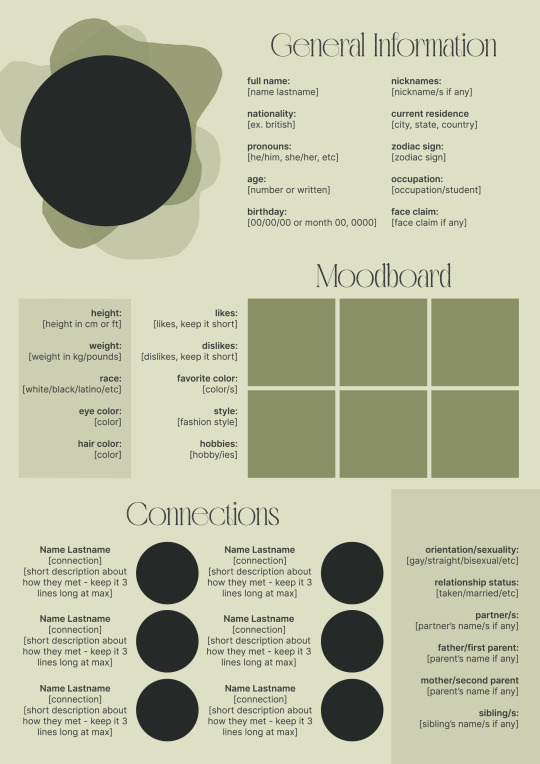
There are two versions and both are almost exactly the same; but the example shown in the left has an 'appearance' section which is small and has few quick facts regarding the oc's appearance; while the example on the right has a 'moodboard' section instead which allows you to add more info about your oc.
You can change every section/title to fit your needs like I did in the examples below; I personally removed some categories as well and got rid of some connections as this oc doesn't have that many close friends/partners to fill the original template. However, I also included an extra separated 'connections' section in the download in case you want to add more people and more information.
I recommend you stick to square-shaped pictures so it's easier to fit them to each section. Also if and when you edit the information or section titles, please select only one line at a time to replace it so you don't lose the text format. (Titles shouldn't change because that's a single format/font within the same text box, but should it change you can always hit ctrl+z hehe) When you're done, I strongly recommend you save this as a .png instead of .jpg so it's the best possible quality!
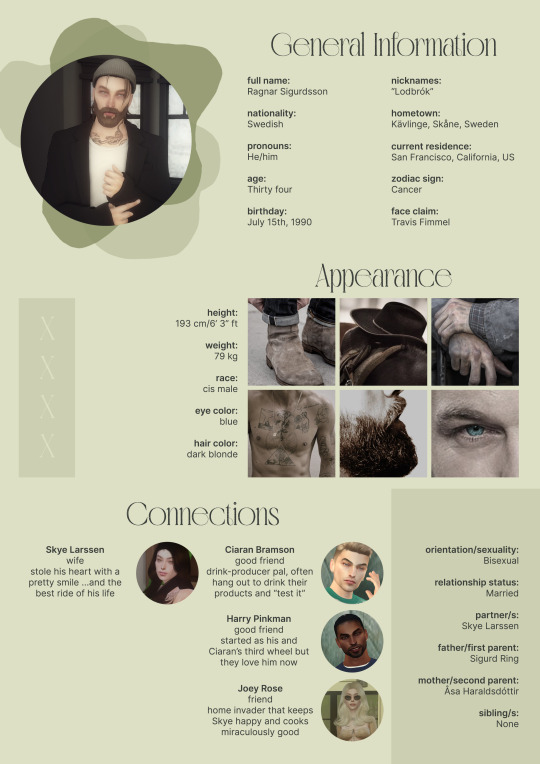
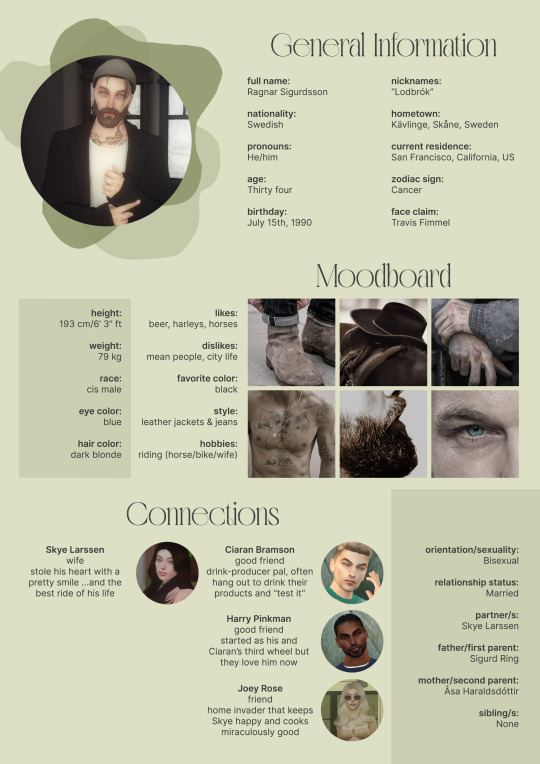
Last but not least, this is a .psd file. So you'll need either Photoshop (I did this with Photoshop Portable, but it supports newer versions of PS and it *should* support older versions too) or Photopea to open and edit this file.
Credits: Adobe Photoshop, Inter font, Golften Vintage font
>DOWNLOAD< (patreon but free :p)
(note: I'm posting this with my gaming blog because I think my fellow gamers might be interested in this, but please consider giving credits to me if you use this template by tagging @synindoodles instead of this blog)
More info on how to use and edit this template below the cut!
Layers:
>Each layer is properly named and categorized. The general layers such as the background, the icon shape and background shapes are under the groups.
>If you don't want to see/don't need one of the connections' pictures and information, I recommend you find which one it is (1, 2, 3, 4, 5 or 6) and click on the eye symbol next to the layer to hide it so that way if you ever need it, it won't be truly gone.
>To edit a text section, simply find the layer (such as General Information>Left Column) and double click on the 'T' symbol next to the layer. That way it will open edit mode and allow you to edit the text, just don't hit delete or enter while everything is selected or you'll erase it :p
>Main text sections aren't separated, they're blocks of text. I recommend you don't remove the amount (for example, if you downloaded the version with the 'appearance' section, which has 5 sections of information, don't remove the fifth line.) Either leave it empty or replace it with another data, otherwise it will look weird. The 'general information' section might look good even if you remove a few lines, just don't get rid of the whole block of text.
Pictures:
>To add a new picture, simply paste it over this document and move it using the Move Tool.
>To frame it (so it becomes a circle or fits over the shape you want), make sure the picture layer is over the layer you want, then while holding alt click between the two layers. [For example, if you want to add a new main oc picture: 1) paste the pic you want, 2) move it with the Move Tool so it's covering the big circle, 3) once you've fully covered the shape (if it isn't you can resize it by right clicking on it then on 'free transform', sometimes you might need to hold shift to proportionally resize it) make sure the newly pasted pic layer is over the layer named "picture goes here", 4) hold the alt key and hover your mouse cursor over the line between your pic layer and the circle layer until you see an arrow going down symbol, once you see it click it and tah dah! your picture should now have the same shape as the circle! - you can further move it if it doesn't fit the way you want with the Move Tool (;
Others:
>You can change every color, font and section to your liking, just don't change the general layout of the template.
>To hide/show the guides (those bright blue lines all over the document), click ctrl+,
>'Inter' is a free font and you can get it in the link above (linked with the credits), Golften Vintage is not, but you can get the demo version >here< (just scroll down and click the blue download button under license). I will not tell you how to install fonts as it might be different for everyone (for me it's C:/Windows/Fonts and I just drop the zipped files (except the .txt one) there), but google is your friend.
>I can't think of anything else that needs to be said here, but if you have any other question feel free to send me an ask or dm and I'll help you out!
>Last but not least, a like is appreciated if you plan to use this plus consider tagging @synindoodles if you use it <3
#psd template#template#characters page#muses page#muse page#muse template#character template#character page template#oc page#oc page template#synindoodles#rp resources#rp template#roleplay resources#roleplay template#writers resources#writing resources#writing template#writers template
173 notes
·
View notes
Text
[MAJOR SPOILERS] up to the end of 6.0: Elidibus knew the future, and how translation harmed it's impact.
I posted this on twitter, but almost no one saw. As such I'm uploading it here, not only because I can go into more detail, but because I think this is one of the most important aspects to Elidibus' character that I never see anyone talk about.
Elidibus knew the future. This has been DIRECTLY stated since 2.55... but what you may not know is that this has been indirectly hinted at (more explicitly in Japanese) since Elidibus' first appearance in 2.1. In this sickly written 'essay,' I will be sharing with you all an incoherent babble of Elidibus' story, along with major changes in the English translation that diminish the legitimacy that he knew the future before becoming Zodiark.
Please note: Tl;dr version is at the bottom, for this post IS long. Tl;dr implores you to at least look at the images provided below.
Let us begin not at 2.1, but rather 5.3. The most important translation difference in my personal opinion. It is your climb up the crystal tower, and Elidibus stands before it's throne. As he awaits your arrival, he ponders the crystal in his hand. The crystal of the Exarch's memories... memories of a possible future.
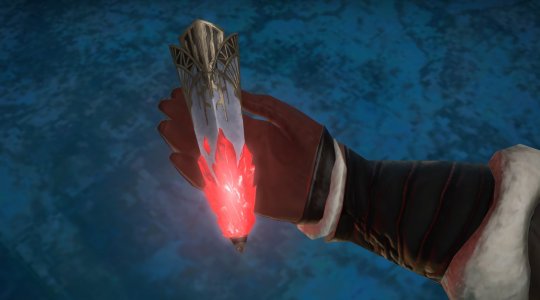
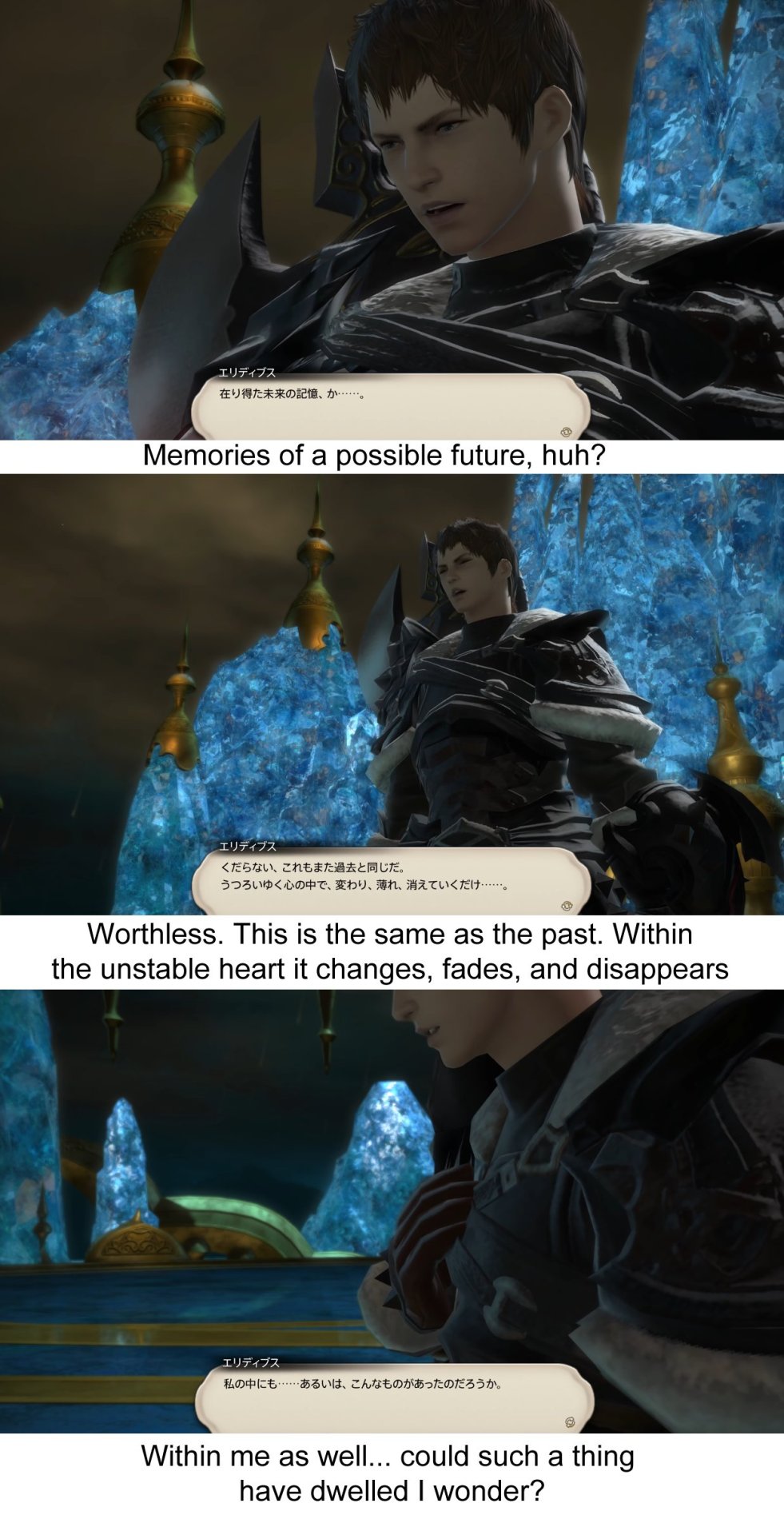
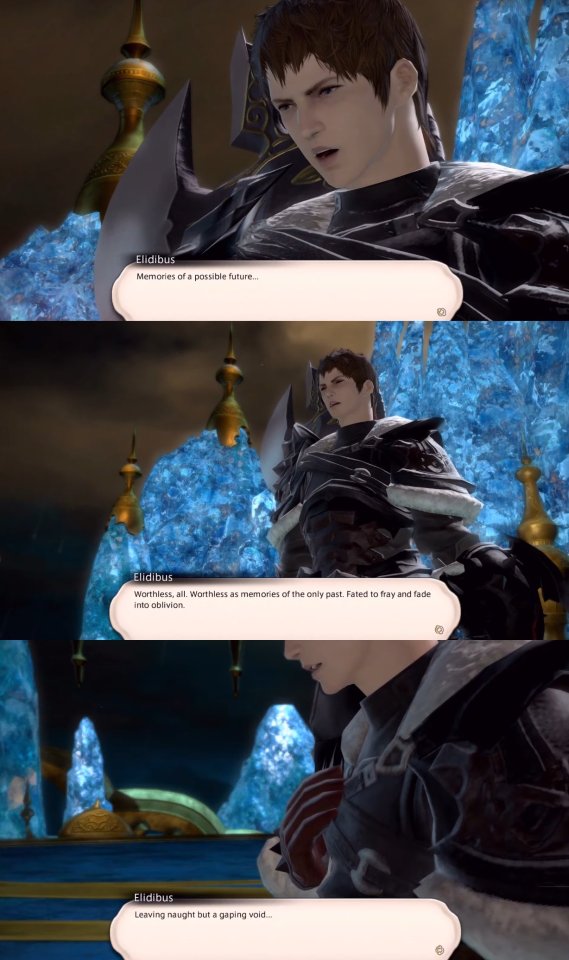
For those who may not be able to see the images above, I will summarize the difference. While most of the translation is the same between Japanese and English, there is one major difference.
In both versions, Elidibus looks at the Crystal and calls it worthless. A possible future is the same as the past. It is fated to fray, fade, and disappear. In English he follows this with "Leaving naught but a gaping void..." Meanwhile, in Japanese he says "Within me as well... could such a thing have once dwelled, I wonder?" (keep in mind I'm trying to keep the translation here as exact as I can, including the awkward structure, as I want it to be easy for people to compare my translation to the original text.)
I think this is very... very interesting. While I, at times, adore Square Enix's liberties in translation (otherwise we would not have the absolute banger “The rains have ceased, and we have been graced with another beautiful day. But you are not here to see it.”), I think this was an interesting moment to take liberties.
What's done is done however, my main focus on this essay is not to criticize the translations though. It is just to inform what I believe is true about Elidibus' character. As such, I will no longer be addressing translation differences beyond providing them for context.
So let us move on to discuss the very interesting implications this has, using the short story "Ere Our Curtain Falls"


English version: "Will you not look at your crystal?" I asked.
When Elidibus was still Elidibus and Lahabrea still Lahabrea, we had collected all of our memories of the Fourteen and committed them to crystal, that those who would take our seats one day might learn. Elidibus would, I was sure, find much within to help him remember─yet he shook his head.
"I am Elidibus. So long as I remember my duty, that is enough. Aught else I would only lose again in the course of this timeless struggle...and if these memories are truly so precious, pray do not ask that I forget them twice."
The last part in Japanese: "I am Elidibus, and I remember what I need to do, and how to accomplish it. That is enough. Even if I remember this or that, I will lose it again in this continuing battle. If it is an important memory, don't make me forget over and over again."
(Link to Japanese story, which you can switch into English, at least on desktop, at the top right of the page)
Elidibus thinks a crystal that holds memories of a possible future is worthless... and he refuses to look at his own memory crystal... how interesting... very very interesting.
As a quick refresher of the important things that occur next: You fight Elidibus and put him in the crystal tower. The final days begins again. Left with no one else to turn to, we go to speak to Elidibus at the crystal tower. He remembers us in the past, and knows where he must send us... which is something that can only be done THANKS to him being sealed in the crystal tower.
And now I feel we can move on to OUR beginning of Elidibus, aka 2.1. Though there is a LOT of text that I feel should not have been altered, I only translated what I feel matters most to me. A specific piece of information that had it's implications completely altered, and the implications that Elidibus goes out of his way to TEACH Minfilia about the ascians.
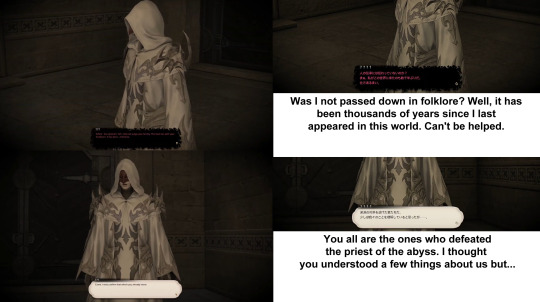
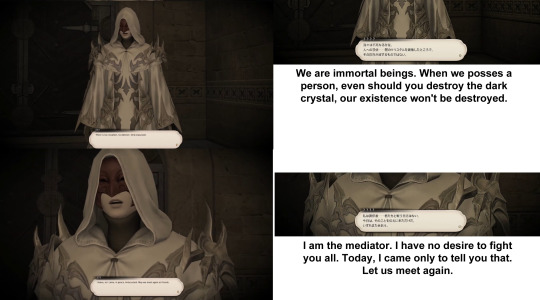
(I will only transcribe the translation.)
"Was I not passed down in folklore? Well, it has been thousands of years since I last appeared in this world. Can't be helped. You all are the ones who defeated the priest of the abyss. I thought you understood a few things about us but...
We are immortal beings. When we posses a person, even should you destroy the dark crystal, our existence won't be destroyed.
I am the mediator. I have no desire to fight you all. Today, I came only to tell you that. Let us meet again."
Kiiiiind of strange that he would just casually tell us that they can't be defeated like that. What is there to gain in giving away such a secret? Perhaps he's cocky... or perhaps there's more.
to recap what matters in the next patch, 2.2: The sahagins are preparing to summon Leviathan. Y'shtola spies on them, and hears them speak of how they're going to ascend in power (a parallel to things Elidibus said to Minfilia.) We decide to investigate, and witness the Sahagin priest ascend into "immortality," before watching his essence be absorbed within Leviathan, with him questioning why the emissary/white robed one seemed to have tricked him.
Now keep in mind, before this patch, it's already established that Lahabrea is the one to promote primal summonings, AND that Lahabrea is back. What reason would Elidibus have to no only promote the summoning of Leviathan, but to risk teaching immortality to the Sahagin priest, especially when he KNOWS the scions are in direct opposition to not only to the ascians but to primals? And for this to be one of the first things he does, after thousands of years of not appearing in our world, and AFTER he approaches Minfilia to speak of seemingly only non-sense. What, oh what could be the purpose?

"My power... it's being taken... I'm being absorbed by the great water god? Did I... not become... immortal? White robed one... what... is this?!"
It is thanks to this "slip" in Elidibus' decision making that we learn that the ascians are in fact NOT immortal. They are simply beings of aether that have not dispersed. They can be ABSORBED within something, and when that something is destroyed, they don't return. It is directly thanks to Elidibus doing this that we learn not only how to defeat him and his brothers... but also that we can seal him away in the crystal tower.
Surely this is just coincidence, right? There's just no way. Clearly this is all set up to be a piece of sad, tragic irony right?
I take us now to the very final cutscene of 2.55. Though there are differences in translation, I find them mostly negligible. As such I will speak referencing the English translation.
The final cutscene features Lahabrea and Elidibus. Elidibus appears within Lahabrea's shadow to speak of Nabiales' death before the camera changes, placed in a cage and peering into the other side where Lahabrea and Elidibus stand. The bars of the cage separate them, though the darkness makes it hard to see.
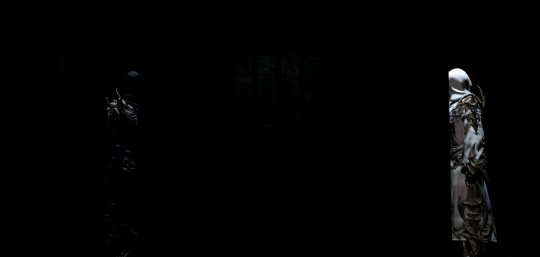
Elidibus says that the warrior of light is becoming too strong. That they must make haste to stop them. He suggests Lahabrea head to the northern lands, and Lahabrea agrees and departs.
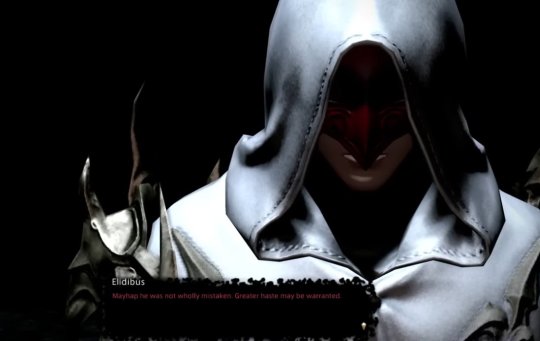
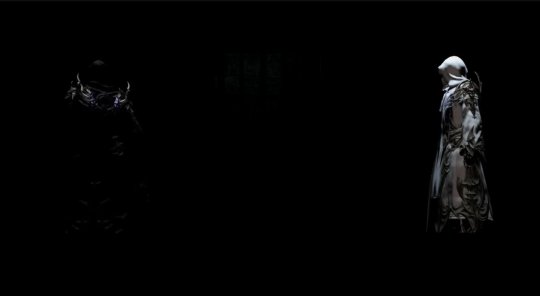
Urianger appears from the dark behind Elidibus, wishing to know why he has been summoned. To which, Elidibus says the he wishes to speak of fate.
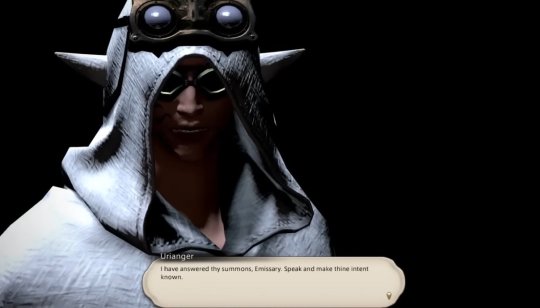
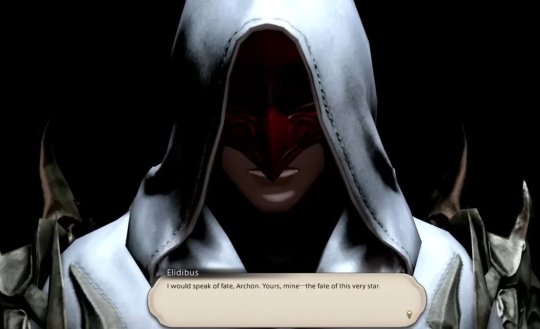
Now why does he do this? As a reminder of what comes next: We defeat Lahabrea, Igeyorhm, and Thordan. This leads to there being no calamity on the source ready to absorb the 1st after it succumbs to light, and the Garleans having access to Azys Lla, meaning they have direct access to the warring triad.
All of this happens at the very end 3.0. However, this conversation between Urianger and Elidibus happens in 2.55. Even should you try to argue that it doesn't take place exactly when it's shown to us, it does HAVE to happen before the mid point of 3.0 at a minimum considering Lahabrea is obviously alive in this cutscene, and more than likely happens before you cross the bridge into Ishgard.
The only thing left to truly note when it comes to this topic is that all of this is reinforced in 3.1 with cutscenes in the Great Gubal Library (2nd to last cutscene of the patch)
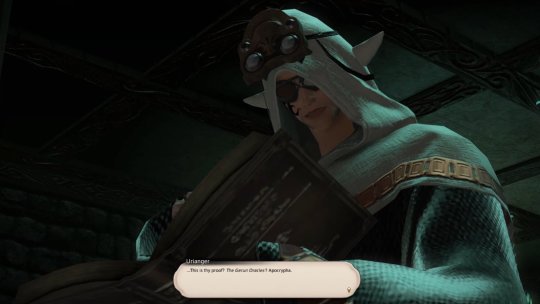
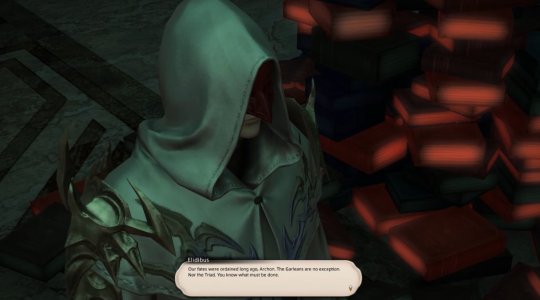
"This is thy proof? The Gerun Oracles? Apocrypha."
"Our fates were ordained long ago, Archon. The Garleans are no exception. Nor the Triad. You know what must be done.
In conclusion, Elidibus knew Lahabrea would fail, and that he would need Urianger for not only the warring triad, but to get Minfillia to stop the flood of the first. It was a fate ordained long ago, for we are in a soft timeloop.
Now you may ask, how can you explain him knowing to do this despite his memory loss? If this is all the case, why does he fight us at the crystal tower so genuinely? To be blunt, I cannot give you a direct answer, outside of what is stated above. Elidibus seems to know on SOME level 'some' kind of goal. Specifically saying "I know what I need to do, and how to accomplish it."
Does he directly state what this goal is? No. Ultimately everything above can only be counted as speculation, but personally, I am of the mentality of "why show us this if it's not meant to mean something? Why does Elidibus do something that has already been established as another character's role? Why would THIS be the first thing he does in our world for thousands of years? Why have a character do this if it's not meant to mean something? Especially when THIS something (teaching immortality) leads to the DIRECT consequence of being sealed in the crystal tower, which is our ONLY way to go THAT far into the past to know about Meteion?"
When did he learn the future? That also would be speculation, but as Emet-Selch states, the memory crystals were made before the Zodiark's summoning. If they are truly eluding to his crystal holding memories of a possible future, and the Japanese version of Ere Our Curtain Falls specifically states that he's been losing himself and his memories since the moment he fell from Zodiark to help the convocation, then chances are high it's before the summoning. Who told him would be pure speculation, but the most likely answer is either Venat, Azem, or the Warrior of Light. And before anyone brings this up, no, I do not believe the writers are going to drop every character related to Zodiark and Hydaelyn just because we're moving on to a new chapter. The consequences of the past will continue into the future. While the ancients may no longer be the FOCUS of the story, I doubt we're never going to see them or interact with the past ever again. They will more than likely be explored further in side content ([SPOILERS FROM DAWN TRAIL TRAILER] given Solution 9 has text in Proto-Alphabet, aka the alphabet of the ancients... yeah... um... don't think our explorations related to the ascians and the past are over.) [SPOILERS OVER]
Now, I still haven't worked on translating 4.X, so I will make no comments towards it and any information it might hold in terms of Japanese Elidibus' views on not only the world, but of the future. Perhaps when I have time to translate it I will make a follow up post. I will also be posting some of my smaller translations from twitter to tumblr in time.
Tl;Dr: Elidibus thinks a crystal of a possible future is worthless. He refuses to look at his own crystal. Because his crystal was made before the sundering, he knew the future at least before that point.
Elidibus taught us indirectly how to seal away ascians, and summons Urianger to help him before there is even a CHANCE of knowing he'd need him unless he knew the future.
With this in mind, it's clear to me that Elidibus guided our path into sealing him into the crystal tower so that he could make the time portal and secure the soft timeloop we're in. Though chances are HIGH this is all subconscious the entire time because of memory loss.
Thank you for coming to my Elidibus Talk.
#ffxiv#ff14#final fantasy xiv#final fantasy 14#ffxiv spoilers#ff14 spoilers#Elidibus#Themis#ffxiv Themis#Final Fantasy 14 spoilers#Final Fantasy FFXIV Spoilers
23 notes
·
View notes
Text
Gender and Sexuality Analytical Application
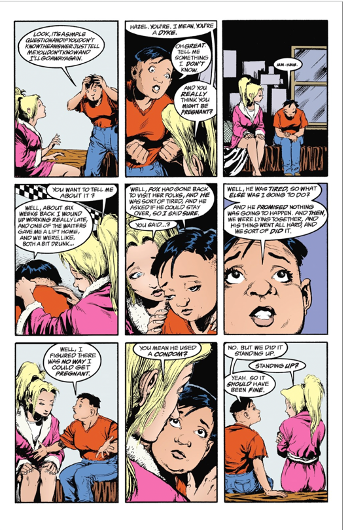
Butch:
Butch is a specific label within the identity of ‘lesbian.’ Typically, we understand ‘butch’ as a masculine woman, but this identity also functions as an identifier for other lesbians. Halberstam writes that “the butch stereotype, furthermore, both makes lesbianism visible and yet seems to make it visible in nonlesbian terms: that is to say, the butch makes lesbianism readable in the register of masculinity, and it actually collaborates with the mainstream notion that lesbians cannot be feminine.”[1] Due to this, the butch turns into a stereotype of the lesbian community rather than a subset of lesbianism. There are certain roles and acts that butches are allowed, and others that they are not, otherwise they risk breaking the mold set by society’s assumptions about the people behind the label.
In the above page from The Sandman: A Game of You by Neil Gaiman, there is a subversion of the stereotype of butches with the character of Hazel. When the reader sees Hazel, the visual cues lead them to believe that she is a stereotypical butch upon first look. And indeed she is a butch. What this page does magnificently is disrupt the hyper-masculine image of a butch lesbian by having Hazel come to her friend Barbie—a feminine straight woman—about possibly being pregnant. This question shakes up Barbie as well as the reader; two panels are devoted to Barbie rationalizing that Hazel had sex with a man in the first place. Due to the stereotype of butch lesbians being hyper-masculine and also typically having femme partners, the idea of Hazel with a man is an inherent disruption of the stereotype. By allowing a butch to act beyond what the stereotype dictates, A Game of You sets up Hazel as a butch that does not conform to the norm. Breaking out of this stereotype is important for butches, as it will allow the other identities within the lesbian community that are constructed around ‘butch’ to break away from butch and construct their own multifaceted identities as lesbians.

Male gaze:
The male gaze relates how women are viewed by men, specifically in film. There is an aspect of fantasy to the male gaze, which projects its desires onto the female figure. Mulvey states, “women are simultaneously looked at and displayed, with their appearance coded for strong visual and erotic impact so that they can be said to connote to-be-looked-at-ness.”[2] There is little agency for women in the male gaze because their bodies and actions are dictated by what the man viewing them wishes.
The above panel of The Sandman: The Doll’s House shows part of the tale that men in the community tell each other through generations. The composition of the panel shows the tale in the larger square panel, then the older man who is telling the tale in four skinnier panels below. The man in the tale—Dream—and the old man in real life are drawn from the same low angle, where Dream watches Nada, his love, throw herself off a cliff instead of choosing to stay with him. The parallel between Dream and the old man connects the men that tell the tale in the community to the main male character in the tale, solidifying Dream as the self insert character for men. This is interesting because Nada is set up as the main protagonist of the tale, and despite having more agency than Mulvey would describe women having under the male gaze, she is still a prize to be won by Dream within the story. However, with the rest of the context of this issue, the narrator tells the reader in text boxes bracketing the beginning and end of the comic that there are two versions of this tale circulating: the one the men tell each other—the one we the readers are told—and the one the women tell each other in a secret language the men do not dare to learn. By leaving out the women’s tale, The Doll’s House positions the reader with the men of the community, and by proxy, Dream. We are forced to participate in the male gaze by pure omission of the women’s side of the story, completely intentionally. Perhaps this was done to emphasize the lack of agency women have in telling their stories under the male gaze.
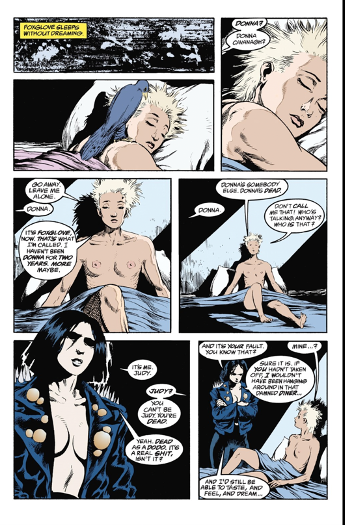
Queer gaze:
The queer gaze is in direct opposition to any gendered gaze that has been used to analyze cinema thus far. There is a tendency for psychoanalytical theories of viewing to be strictly gendered, and as the queer gaze rejects the gendered aspect of this type of viewing, it also rejects the more psychoanalytical aspects as well. Halberstam writes about the queer gaze in relation to Mulvey’s thoughts on the male gaze, calling for new terms with which to discuss cinema that were previously unimaginable, avoiding psychoanalytic terms. “Queer cinema, with its invitations to play through numerous identifications within a single sitting, creates one site for creative reinvention of ways of seeing.”[3]
Through this page of The Sandman: A Game of You, Neil Gaiman depicts two women in a way that forces the reader to view them through the queer gaze. Subversions of typical gender norms cue the reader into the queer reading, but again it is the composition that aids the reader the most. The two panels in the middle of the page show the naked form of one of the characters, Foxglove. The angle is straight on, betraying no emotion, simply showing her as she is. Under the male gaze, this panel would have been used to sexualize Fox and the female body, but through the queer gaze, she is simply allowed to exist in her natural state. The next couple panels show Fox’s old lover, Judy. The first look we get of her is a low angle where her character overlaps with the border of the panel above. Her presence is already too big to be contained within a single panel, only emphasized by the leather jacket with spikes that enlarges her figure. Despite the clear indicators of femininity to a viewer—breasts showing and a feminine hairstyle—Judy manages to retain aspects of masculinity through her character design, though she isn’t quite ‘butch.’ Due to the subversion of what viewers expect from the male gaze in panels such as these, a less gendered form of viewing emerges from these panels—a queer gaze. Of course, this gaze is aided by the fact that the women were lovers; queerness is explicit and implicit here.

Gender norms:
Gender norms are established concepts or acts that group people into one gender or another. Typically, we see this most within the gender binary: male and female. Butler would have us recognize that such norms under regimes of power are realizable and not realizable. “This 'being a man' and this 'being a woman' are internally unstable affairs.”[4] Gender norms are standardized for those that fall within the gender binary, but they also are designed to be unattainable so that people are always trying to reach for a goal instead of reevaluating the value of such norms under a power regime.
In The Sandman: A Doll’s House, gender norms are upheld through the interactions characters of different genders have. However, they are upheld through nontraditional ways, as the characters do not represent typical archetypes of each gender. In the above panels, the male character Gilbert saves the female character Rose from being mugged in an alleyway late at night. Gilbert embodies standards of masculinity like chivalry, protectiveness and kindness. Though the narrative allows him to show strength—as seen in the topmost left panel having beaten up the would-be muggers—he is not consumed by it as many male protagonists are in action films. Such protagonists may feel entitled to women and their attention having proved their physical prowess, but Gilbert is different. In that aforementioned panel, he is positioned behind the muggers, taking up less than half the panel. His strength is not romanticized, merely used in an act of kindness for Rose. She also adopts some classic tropes of female protagonists, such as being in danger and needing a man to save her. However, her status as ‘damsel in distress’ is more of a right place wrong time type of situation, where luck was on her side that Gilbert showed up to help. Her agency is never diminished; Gilbert even asks her if she wants to kick the muggers, but she responds, “No, no thank you. These are nice shoes.”[5] In the center panel, despite their height difference, Gilbert defers to Rose, bowing his head towards the woman standing tall in front of him. Showing the complexity of how people interact with gender norms proves Butler’s notion that there are attainable and unattainable aspects of gender.

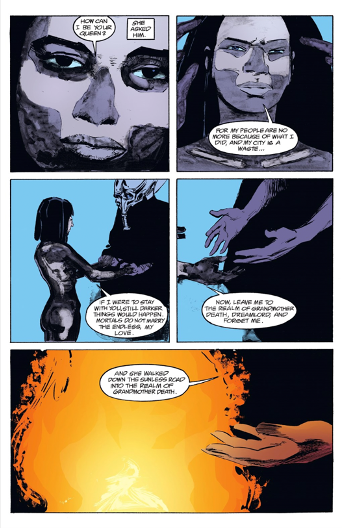
Oppositional gaze:
The Black female oppositional gaze is a form of viewing cinema that Black women utilize in order to see themselves represented onscreen without negative racialized or sexualized representations. In bell hook’s work, she writes that Black women “saw cinema's construction of white womanhood as object of phallocentric gaze and choose not to identify with either the victim or the perpetrator.”[6]
I chose two sets of panels for this term because I believe the first exemplifies the erasure of Black women and therefore the oppositional gaze, while the other represents Black women havin agency over their lives and stories, a direct installation of the oppositional gaze. The text boxes in the first panel detail the two different stories that are told in one Black community: the one passed generation to generation by men, and the other by women. We are never explicitly told the women’s versioni of the tale in the issue, which is a direct denial of the oppositional gaze. Without even being shown a single Black woman outside of the visualization of the tale the men tell each other, how can one even use the oppositional gaze? This is why the second set of panels is important; it gives Black women an opportunity to use the oppositional gaze, which is incredibly necessary since this story is being told by a man. Within the panels, the female protagonist Nada refuses to be Dream’s lover because of the consequences that fell upon her people when she slept with him once. He had threatened her with an afterlife of eternal damnation should she refuse him, yet in this set of panels, Dream does not speak. Only Nada speaks, asserting her beliefs and values before walking away from Dream and into the arms of Grandmother Death. This exemplifies hook’s assessment of the necessity of the oppositional gaze where Black women do not identify with the victim or perpetrator.
[1] Halberstam, Looking Butch
[2] Mulvey, Visual Pleasure
[3] Halberstam, Looking Butch
[4] Butler, Gender is Burning
[5] Gaiman, The Sandman: A Doll��s House
[6] hooks
Bibliography:
Butler, J. 1999. "Gender is Burning: Questions of Appropriation and Subversion." In Feminist Film Theory. Edited by Sue Thornham. New York University Press: New York.
Gaiman, N. 1989. "A Doll's House." The Sandman. DC Entertainment: Burbank.
Halberstam, J. 1998. "Looking Butch: A Rough Guide to Butches on Film." In Female Masculinity. Duke University Press: United States.
hooks, b. "Oppositional Gaze: Black Female Spectators." In Feminist Film Theory. Edited by Sue Thornham. New York University Press: New York (2009).
Mulvey, L. 1975. "Visual Pleasure and Narrative Cinema." In Film Theory and Criticism. Edited by Leo Braudy and Marshall Cohen. Oxford University Press: New York/Oxford (2009).
@theuncannyprofessoro
0 notes
Text
One-roll turn undead
I read Marcia's notes at Traverse Fantasy about one-roll turn-undead house rules with great interest. The second roll for HD turned we have, passed down via Swords & Wizardry variants, is one of the sticking points for new players, as well as just being unaesthetic. Asking someone to roll the same dice again to find the actual result, ugh.
However, I don't want to use Marcia's solution directly. Roll-under is a neat tool here but I don't think it's the one I want. In particular, I've come around to seeing the Turn Undead roll explicitly as a variant reaction roll (I even call for a Charisma modifier), and I don't want to break that relationship. So I dug in a little more.
I quickly noticed a few things about OD&D, that like many other things from the supposed "retro-clone" S&W and other variants we've based the rules on, are quite different. We've long-since ditched the ugly 3d6 turn roll that tries to walk the line between AD&D's d20 and OD&D/Basic's 2d6, but here are the rest:
OD&D has 2d6 as number turned, not HD turned as in later versions. A better rule!
In fact though, 2d6 is only listed as the result for a T or D, an auto-turn. While the default reading of the text seems to be to use it for all successful results, using a single roll seems valid here, as does saying only a single undead is turned on a successful role!
The turn chart we have been using, which I believe I swiped from Labyrinth Lord, does not closely resemble OD&D or even B/X. Both of these sources are considerably more generous with auto-turn and destroy results. No wonder a whole generation of OSR people think Clerics are bad!
Yes you can turn every round. It's your main thing, go for it. Anyone who says otherwise is being silly.
So we are trying a new rule. Here I am writing it out for the first time. I've included a new, wholly original turning chart that I hope feels about right—if you are viewing this post on the tumblr dashboard, you'll have to go to the blog to view it. There are some trade-offs here vs. the older version: a low-level Cleric is going to turn slightly fewer foes, but is given better odds against solo powerful ones, and generally spends fewer rounds doing nothing. A high-level Cleric is maybe slightly stronger against most encounters.
It's possible that we may find this slightly too strong, in which case we will perhaps fall back to the OD&D chart with this rule. Not sure yet.
It's worth noting that my interpretation is also influenced by some historical reading like the one by D.H. Boggs.
Turn Undead
Clerics use their holiness to drive off otherworldy evils. Stand your ground and make a recitation, holding forth your symbol, and then roll a reaction check (2d6), and consult the Turning table for the result. If you score the number required, one of that monster will be forced to turn away from you—plus one for each point you score over. These monsters may still approach your unguarded friends if you break ranks, however the effect last as long as your presence does, and further attempts may add to the count of those affected.
A “T” indicates automatic success—the number you roll on your check are Turned. On “D”, they are struck down and destroyed instead.
If mixed undead are present, turn the lowest type first. If you turn them all, subtract the score you used for their number and target, and apply your remaining roll against the next type up.
The feared Anti-clerics instead awaken the dead that not have had last rites. Skeletons and Zombies mindlessly follow commands until dawn, or permanently on a “D” result, but other undead must be bargained with.
Cleric level: 1 2 3 4 5 6 7 8 9 10 Skeleton 5 T T D D D D D D D Zombie 7 5 T T D D D D D D Ghoul 9 7 5 T T D D D D D Wight 11 9 7 5 T T D D D D Wraith 11 9 7 5 T T D D D Mummy 11 9 7 5 T T D D Spectre 11 9 7 5 T T D Vampire 11 9 7 5 T T Accursed* 11 9 7 5 T Demon† 11 9 7 5
* Accursed dead include Ghosts, Liches, Banshees, or other unique haunts tied to a specific place or thing.
† Demons can also be turned, but apply their Type as a penalty against the Cleric.
1 note
·
View note
Text
E-commerce Website Accessibility Guide

Web accessibility is not a privilege, but a common need. In times when everyone is shopping online, the e-commerce experience should be provided equally for all. This includes people with disabilities, visually impaired users, and other vulnerable categories.
Nowadays, two of the biggest web standards organizations are supporters of e-commerce website accessibility. The World Wide Web Consortium (W3C) is the major standards organization, and its WCAG guidelines offer designers and developers many tips and advice on making sites accessible.
Below, we are showing you the ways you can make your website and online store accessible for people who use screen readers and other forms of assisted technologies.

What Is Web Accessibility For E-Commerce Websites?
First of all, you should know that web accessibility is an initiative that demands that all web content on your online store is coded and designed so that individuals with disabilities can interact with it. The range of disabilities is wide, including users with sight, movement, and cognitive impairments.
The website accessibility standards are mandatory according to the Web Content Accessibility Guidelines (WCAG) which are currently at version 2.1 and focus on certain principles to address all accessibility issues people have.
The guidelines are divided into four main categories, where content must be:
Perceivable: To make the content perceivable, it is recommended to follow principles such as adding alt text to non-text content, using low contrast between text and graphics, providing transcripts for audio and videos, and more.
Operable: In web accessibility, operable websites are ones that have a user interface that is very clear and straightforward to the user, so that they can freely and easily navigate throughout the e-commerce website. To meet these accessibility standards, your site needs to be operable using just a keyboard (without a mouse).
Understandable: Whenever a user interacts with the online store, they should be able to understand the content and operate the user interface. Accessibility is all about making it clear and easy to use.
Robust: Last is robustness – to meet the accessibility guidelines, you should also make your e-commerce store robust. This is purely technical and requires using valid code markup when implementing the website. As a result, your online store will be more effectively interpreted by assistive systems and technologies.
Essentially, web accessibility demands that content should be presented in a manner that makes the most sense to tackle common accessibility issues. Website owners also need to consider writing alt text for images, providing transcripts for both audio and video content, low-contrast text and graphics, and more.
Why Is Web Accessibility Important In Online Stores?
Statistics show that more than 1 billion people all over the world and almost 57 million Americans have certain forms of disabilities, and over half of them are experiencing severe disabilities. While they are not the same, all disabilities demand certain modifications so that everyone can use the Internet freely and shop from e-commerce stores.
Aside from meeting the regulations and addressing e-commerce website accessibility for people with disabilities, an optimized e-commerce website will prevent driving away visitors and is likely to improve (otherwise lost) revenue. The user experience on accessible websites is cleaner and much better for everyone, addressing all challenges and meeting all accessibility standards.
All of these people use assistive technologies like screen readers, screen magnifiers, text-to-speech systems, special browsers, and more. In the next part, we will break down all of these categories and their limitations, as well as the actions needed to address them.
Common Shopper Limitations And The Best Solutions For Ecommerce Website Accessibility
We all know that web accessibility is a form of optimizing your website to comply with regulations and also address user challenges. The best way to do it is by understanding the various shopper limitations and modifying your e-commerce website according to them.
Visually impaired and blind shoppers Believe it or not, more than 1 billion people around the world suffer from some form of vision impairment. To align and make your website accessible for visually impaired and blind shoppers, your store design needs to accommodate the technologies they use to access web content. Screen readers are one of the most popular software solutions that shoppers with visual impairments use. A screen reader is a software that allows them to read the web content clearly, either with the help of a Braille display or a sound synthesizer. To address web accessibility, you should ensure that your website design is compatible with the latest version of the popular browsers, but also align it to specific browsers like MozBraille, EMACSPEAK, and pwWebSpeak that are used by this group of people. Lastly, focus on avoiding any high-contrast color schemes (with no flashy objects) and make your e-commerce business store as simple and as minimalistic as possible.
Colorblind shoppers Color blindness is another form of impairment that affects e-commerce website accessibility. Addressing these changes in your web design to help users with disabilities like these is simple. The first step you should make is to ensure that the colors you use are at the opposite ends of the color wheel, preventing any confusion among people with color blindness. Next, make sure that your buttons also have color contrast and add some texture, shapes, or other cues in them to ensure that you have an accessible e-commerce website.
Users who are deaf or hard of hearing More than 466 million people have some example of hearing loss. All of these can be your customers, which is why you should make your business sites accessible to this specific group. If you are wondering what some of the challenges faced by customers with hearing impairments are, they are generally related to difficulties in reading text because they are used to sign language as their first language. So, one solution would be to create sign language videos for every part of your website. Even though it might take some time, people with visual impairments will appreciate your company and navigate through your sites easily. Another quick solution is to add captions to your videos.
Elderly shoppers We all know that elderly people love shopping and are an appreciated group of customers for most e-commerce business owners. Estimates show that 7% of the global internet audience is people aged 65 and above. To address web accessibility compliance, you should optimize your online shop and fix some of the things that prevent users from freely navigating through it. One of the biggest challenges these people have is related to their weak motor skills, which prevents them from interacting with some page elements. As a solution, you should meet the ADA accessibility standards by designing your web pages in a way that elements like form fields are not too close to each other. Also, make sure that every page can be navigated through with the use of the keyboard only. Also, most of the elderly have short-term and episodic memory declines. To address this with a solution, you can offer them frequent alerts and reminders, such as an alert that they have products in the shopping cart or website elements showing the latest products they visited.
Users living in developing countries and regions Last is the category of people that are living in developing countries and regions. We all know that the Internet is not a privilege and more people have a screen, mouse, and keyboard than ever before. Still, the only problem that persists is a fast and stable internet connection. If we couple this with the fact that many sites use JavaScript-powered web applications, the page loading speed and overall user experience might drop for users with unstable Internet connections. The easy fix is to use tools like a Content Delivery Network (CDN) for your company sites, which can help you reduce the latency for visitors located away from your business’ server location. Other solutions include creating a cache for page elements that don’t change more often (the footer and navigation bar are examples) or creating a lightweight version of your online store which can be accessed by these users. Now that you know all of the vulnerable customer groups out there and the guidelines to helping each of them navigate through your site in a better way, let’s move to some of the simple steps that you can make to address ADA compliance for all of your website’s elements.

What Are The Simplest Steps To Making Your Ecommerce Website Accessible?
Addressing accessibility has never been so important. If you want to make your store accessible and address WCAG compliance, here are some of the best manual checks that you need to consider:
Start using your store but keep the shoppers with limitations in mind
Look for any images, buttons, videos, and other elements that might appear weird if you take colors out of perception
Investigate potential processes that might affect accessibility and are tedious to perform
If you are using media files, check if all of them can be accessed by the blind, color blind, or people with other disabilities
Check if you have alternate texts that describe each media to an impaired customer
If you are using video, check if the subtitles are aligned and clear enough for people with hearing impairments
Keep the wording to each text link simple, and avoid using links on words like “here”
Build a visual approach that goes beyond pages on your store. For example, you can make your emails and customer support more accessible
Position your navigation bar so that it always appears in the same location relative to other elements
Use a search bar that is visible and sizeable enough so all customers can use it
There is also another approach to addressing accessibility for each customer with disabilities. You can use tools like the following:
ACTF aDesigner, which is a digital disability simulator that lets you ensure that your website’s elements are accessed by visually impaired customers
Pingdom, which is one of the digital tools that address all the slow internet connection issues and does speed tests of your online store
All of these tools are essential and can help you see who can access your sites. They are a great way to ensure that you are meeting all of the compliance requirements.
Final Words
In the end, accessibility is of big importance nowadays. Making your site accessible for all of the vulnerable categories of customers is important, and following the WCAG guidelines can help you set an example in your industry and attract more users. Now is a great time to start doing this and directly attract people who search for accessible online stores.
For more information on accessibility for e-commerce websites, get in touch with us today!
#E-commerce Website Accessibility Guide#web accessibility#adasitecompliance#digital accessibility#ada web accessibility solution#ada site compliance
0 notes
Text
-January 27th, Factory Tyrant's Journal, Mini Entry 24.1-
This journal entry won't actually have any progress in my survival world, instead I'll note what I've learned from testing IC2 nuclear reactors, as well as what I learned from browsing the Industrial Craft 2 wiki.
This is quite long for a mini journal entry, so feel free to skip this if you don't like walls of text telling you how reactors work.
First off, nuclear reactors are more complicated than just "put in fuel rods and coolant, get power".
Nuclear reactors come in 2 versions, EU reactors and fluid reactors, here's what the different types of reactors look like.

From left to right, there's an EU reactor, and EU reactor with 6 reactor chambers, and a fluid reactor.
Fluid reactors aren't a separate block, to make a fluid reactor you have to cover an EU reactor with a hollow 5x5x5 cube of reactor pressure vessels (or reactor access hatches, reactor fluid ports, and reactor redstone ports).
Both types of reactors require a redstone signal in order to run, otherwise they'll shut off.
Here's what an EU reactor's GUI looks like.

In this screenshot, you can also see some different types of uranium fuel rods, heat vents, heat exchangers, and neutron reflectors in my inventory.
You can't place anything in the X marked slots, but you can turn them into regular slots by placing up to 6 reactor chambers directly adjacent to the main reactor block, each reactor chamber will add 6 slots.
Any fuel rods you place in here will generate power, but will also generate heat that you need to get rid of.
The main way to get rid of heat is by using heat vents, which will take heat from adjacent components (or the reactor itself if you have the right kind of heat vent), then expel heat into the air where it can't harm anything.
If a heat vent is taking heat faster than it can expel it, it will start to overheat and eventually break.
Heat exchangers won't get rid of heat, but they can move it between adjacent components to prevent them from breaking.
Heat exchangers will also break if they can't get rid of heat fast enough.
Any generated heat that isn't handled by components goes directly to the reactor's core, causing the reactor itself to eventually overheat and explode, here's what the crater of a reactor explosion looks like.

As you can see, I don't want this to happen right next to my base, luckily this is in a creative mode world I made specifically to test reactor explosions.
One more thing about EU reactors is that fuel rods generate more power (and more heat) when placed next to each other, or when placed next to neutron reflectors.
If you fill every slot with fuel rods, the reactor will explode in less than 5 seconds.
Anyway, onto fluid reactors, which are mostly the same apart from a few key differences, here's the fluid reactor GUI.

Fluid reactors have 2 internal tanks, one for coolant, one for hot coolant.
The functionality of components placed inside a fluid reactor is largely the same as inside an EU reactor, with 2 main differences.
First, fuel rods don't generate power, only heat.
Second, any heat expelled via heat vents is used to convert coolant into hot coolant, which is the only product of a fluid reactor.
If the reactor doesn't have any coolant, heat cannot be expelled, and the reactor will overheat.
In order to get power from a fluid reactor, you need to put hot coolant through a liquid heat exchanger, which will produce regular coolant as well as heat.
Any coolant from the liquid heat exchanger can be sent back to the reactor.
IC2 actually adds 3 different types of energy, electric energy, heat energy, and kinetic (or rotational) energy, although most machines only use electric energy.
Create (not part of TCR) goes a lot more in-depth with kinetic energy/rotational force, in IC2 it's basically just arbitrary game units transferred between adjacent machines.
There are 2 ways to convert heat to electric, either using a stirling generator (simpler, but less efficient), or using a more complicated process which I'll describe below.
Putting heat and water (or distilled water) into a steam boiler (steam generator post 1.12) will cause it to produce steam (or superheated steam), which can then be sent to a steam turbine (kinetic steam generator post 1.12).
Steam turbines turn steam into kinetic energy and distilled water (superheated steam will be turned into kinetic energy and regular steam, which can be passed to a second steam turbine), kinetic energy is passed to a kinetic generator which uses it to generate electric energy.
Any distilled water from the steam turbine can be sent back to the steam boiler.
So that's the extend of my reactor knowledge after looking through the IC2 wiki, but I also did some research on other IC2 things that I'm either using now, or could possibly use in the future.
I think at the point I'm at in my survival world, making a nuclear reactor isn't worth the risk, especially now that I know more about my other options.
First off, I learned the actual numbers behind geothermal generators.
Geothermal generators will generate exactly 20 EU/t (electric units per tick), assuming they're provided with lava, so the 12 geothermal generators I have produce a total of 240 EU/t.
The problem with my setup isn't that I've moved past the point when geothermal generators are viable, it's that I'm still using copper cables for everything, which can only transfer up to 128 EU/t.
The reason my cables haven't burned is because the 240 EU/t of 12 geothermal generators is still tier 1 power, which doesn't burn copper cables, but I still need to upgrade my cables so they can transfer all the power I'm producing.
IC2 cables come in 5 varieties, each one can transfer 4x as much as the last (tin cables transfer 32 EU/t, copper transfers 128 EU/t, gold transfers 512 EU/t, HV (iron) transfers 2048 EU/t, glass fibre transfers 8192 EU/t).
Each cable also loses twice as much EU/block as the last, apart from copper cables (loses 0.2 EU/block, same as tin cables) and glass fibre cables (loses 0.025 EU/block, making them the best cable).
As for my pumping setup in the nether, while I can't easily improve it with Buildcraft, I can improve it with AE2, using fluix cables and ME fluid import/export busses, although this is more expensive than Buildcraft pipes.
I'm probably going to switch over to AE2 for fluid transport next time I play in my survival world.
Anyway, I should probably end this here.
I don't personally think a mini journal entry should be longer than a regular journal entry, but I also don't think I should post a regular journal entry unless I actually play in my survival world.
-End Mini Journal Entry 24.1-
0 notes
Text
You understand The Vision for SURE
Personally the way I envision the whole Specter/Shark/Laurentina triad is very close to what you said:
Specter starts as a very tanky, decently damaging unit with Health Regen (S) (10% per turn) and Bone Fracture as a passive that lets her survive with 1 HP once per battle, and whenever it triggers, she gets +10 Will, +15% Final Damage and +10% Accuracy, but otherwise just has two economic but unexceptional attacks: A regular 1-3 range melee with medium damage, and an EN consuming, 120 Will 1-4 range melee with somewhat higher damage, but otherwise her role is absolutely taking hits. Her animations are robotic, almost creepy.
At the end of Under Tides, on the turn you finally get Specter back from Ventus and Ventus goes full Seaborn, it’s not Specter you get, but rather, Shark, who has slightly reduced bulk but access to stronger regular attacks and a bigger arsenal, and her animations are now extreme and acrobatic (as per the text in Under Tides describing her going full Devil May Cry). You only get Shark as a guest for this second half of the fight, and afterwards, you get Specter back, but she gets a new attack, 2-4 melee, highly EN consuming, 130 Will, which makes her get the Bone Fracture red glowing eye and go full acrobatic beatdown, as if evoking Shark, but the EN consumption makes it very limited. Kal’tsit gives the same explanation she did at the end of Under Tides and the post battle cutscene is an abridged version of Specter’s OpRec 2, mainly focusing on her conversations with Closure, Skadi, and Doctor.
At the start of the sequel, you have Specter, but as we know from the start of Stultifera Navis, she had gotten even worse than before prior to SN, going back to just her 2 attacks. This doesn’t last for too long, as SN would happen early game in Act 2, and midways through the battle in the Stultifera, she has a scripted event in the main hall with the shattered mirror where, due to proximity to the ocean activating her Seaborn cells at full throttle and seeing herself fragmented in the mirror causes something to trigger, to comprehend in her mind, you get Shark again.
After a few rounds of combat with Amaia/Endspeaker triggering special dialogue between the two (as well as giving both of them a hefty +20 Will for dramatic yet tangible effect after their dialogue), Shark has that Unchained OpRec moment of realization where she is, at the same time, Specter and Shark, but also, besides being a palliative war machine, besides being the Executioner of the Second Team... She’s Laurentina, sculptor. She’s all three at once. That’s when she fully goes Laurentina, with new animations, upgraded stats, and a MAP attack where she turns into her Specter Doll form to damage an area and debuff enemies with Evasion Down. It’s at this point that she goes full Mazinkaiser in terms of SRW equivalent: Still very tanky, but capable of unleashing some absolutely unholy damage, as well as gaining access to her Team Attacks (which I imagine would be: 1) Duo TA with Skadi, 2) Duo TA with Gladiia, 3) Trio TA with Skadi and Gladiia, and 4) Final Dynamic Special with Skadi, Gladiia and Andreana.)
As Specter, her Bond bonuses would be minor bonuses with Skadi, Kal’tsit, Gladiia, and Suzuran (we can acknowledge OpRec 1 I GUESS), as Shark, her Bonds are major bonuses with Skadi and Gladiia, minor with Kal’tsit, and as Laurentina, major bonuses with Skadi, Gladiia, and Irene, medium bonuses with Kal’tsit, and minor bonuses with Suzuran and Andreana.
Now and then I think about how the nature of temporality in Arknights apropos of the main story relative to side stories (events) means that with a little effort, you can make a really good SRW-style SRPG with Arknights: There’s the myriad storylines, there’s the myriad characters, there’s a good combination of objective mechanical information and lore fluff for a lot of characters that would let you make really good, complete characters in terms of gameplay.
You could easily make something like:
1st Game: Main Story from Chernobog up until Faust and Mephisto; Break the Ice (can be a sizeable arc, allows for a lot of maps across the game’s length, likely early game until start of endgame); Maria Nearl (same as Break the Ice, midgame until the endgame); Under Tides (shorter than the previous two, end of midgame until the endgame, plus you get temporarily playable Irene in the vein of SRW giving you guest units for one or two maps in one game before they are fully recruitable in the next); Grani the Knights’ Treasure (you can cover this in one, maybe two maps); Twilight of Wolumonde (medium length arc and due to its structure, perfect for sprinkling maps about it across the early to midgame); Heart of Surging Flame (one long map-two maps); Code of Brawl (easy two mapper); Children of Ursus (SRW-style revised to be mixed in with Chernobog part of Main Story); Who Is Real (you can squeeze 2-3 maps easily; start of endgame upgrade for units like Lava and Kroos).
2nd Game: Main Story from where game 1 left off up until Talulah and the Deathless Black Snake, effectively ending the game with the end of the first arc; Beyond Here (AKA Archetto; short arc); Both Gavial Events (you can make big maps with Great Chief, whereas Ideal City would be interspersed with other plots to give it meat in terms of combat, a common event in SRW); Pynus Sylvestris & Near Light (you can get either some real long maps out of this or several medium length maps), Stultifera Navis (around the early midgame, you can squeeze 2 to 3 maps easily, and Seaborn can make for versatile enemy types elsewhere), Mansfield Break (you could put this anywhere, and you can milk it for a number of maps); Invitation to Wine (same as Mansfield Break); Guiding Ahead (you can go crazy with Guide Ahead thanks to the setting of Laterano and the structure of the event plus Andoain fits the “fucking HARD endgame RR boss” archetype with strong attacks and high dodge to a tee); Lingering Echoes (same as Guiding Ahead, really); Dorothy’s Vision (you can squeeze out some 3 maps out of it easily and a lot of new enemy types)
In SRW fashion, the Main Story in general would find itself slowed down and modified with downtime much like the main arc in an SRW tends to be a slow, game-length affair that finds itself entwined with many of the other arcs in the game, and likewise the arcs with the main story and between themselves. Of course, this also diverges from actual canon in that a lot of people that Shouldn’t Be There canonically, in this game’s canon, Would Be There, and that goes for the good guys as much as it does for the bad guys, which is always part of the appeal of a good ol’ SRW. It’d also be cool to see secret recruitable characters that you can’t get in canon or that die in canon join you if you satisfy certain secret requirements, like getting playable Big Bob and Monch and Viviana/Candle Knight, or being able to save FrostNova and/or Faust. Hell, sometimes SRW likes to throw curveballs and give you unexpected characters, so catch me with my endgame maxed out Jesselton (unlock: Defeat Jesselton exclusively by using Mountain, Robin and Kafka in the final Mansfield Break mission) and my #KHAGANQUEST (unlock: Every time Tola appears, defeat him with Blemishine).
I think the main challenge of the game would be to have a cohesive roster; SRW games tend to have massive rosters but that’s due to the sheer amount of stories they tend to cover in one single game, it actually tends to be few characters from each individual story, except the “featured” stories, which get more screentime and roster slots. In regards to some of the arcs, this is pretty easy: Abyssal Hunter Arc characters aren’t many (Skadi, Specter, Gladiia in the first game, plus Irene and Lumen in the sequel) and some of them are universal (Kal’tsit and Elysium), but then you have to make a decision of what 3*s, for example, make the cut as fully playable and not just NPCs, so as to not have bloat: Lava and Kroos are easy picks, for example. Break the Ice can give you a lot of people (SilverAsh, Courier, Matterhorn, Pramanix, Cliffheart, Kjera, Gnosis, secret Monch, secret Degenbrecher), which would make sense if you make it a meaty arc in the game overall, plus there’s a good variety of units you can get outta that.
I think the cast also lends itself to the usual SRW archetype of units: Amiya fits the “RR” type of unit that has low health but high evasion (based on her moves in the trailers, she’s highly agile), Blaze on the other hand seems like a perfect fit for the “SR” type of unit that has very low evasion but instead has huge bulk and just tanks the attacks instead (based on her duty as a Centurion, catching a ton of enemies at once and dealing with them while holding them and tanking them). Other RRs that come to mind are Ch’en, Irene, Whislash, Kroos, among others, while other SRs that come to mind are Specter, Blemishine, Mudrock, Matterhorn, among others. Then you have the less common archetypes, like Getters, AKA glass cannons with average bulk and low evasion but BIG damage, which can be units like SilverAsh (with S3 specifically in mind, giving him huge offense but making him quite fragile) and Skadi (very high HP and damage but low Defense means that HP goes down fast). You’d also have plenty of characters that would make sense to have innate Leadership (buff aura for nearby units), such as Amiya, Kal’tsit, Gladiia, SilverAsh, Big Bob, among others.
It goes without saying that you can make full use of the SRW tradition of giving units specific, very powerful team attacks, some of which could be pure fanservice, like Amiya and FrostNova having a team attack, and others which simply make sense, like the Sui Sisters (Nian, Dusk and Ling), the Abyssal Hunters, Pramanix and Kjera, Big Bob and Mudrock, among many others. The possibilities are legitimately really cool to imagine.
The setting and cast just works for an SRW style game, man.
123 notes
·
View notes
Text
A Megaten apocalypse: the sad case of Inanna

Much critique of Atlus' current direction and of the demon art and writing focuses on Demeter. However, in my opinion it's Inanna who best embodies the problems the franchise currently faces. Demeter at least has the cornucopia; Inanna, both her design and how she's written, are actively an antithesis of who she was to ancient Sumerians, Akkadians and other cultures of the region. Read on to find out more. Take into account that some of the quoted texts are explicit, though.

The issue here is simple: both the design and the writing in SMT IV Apocalypse reduce Inanna to a single function: that of a pregnancy monster, obsessed with having children and with basically no character otherwise. And the grotesque form naturally follows this function. Of course, a degree of simplification is necessary in modern adaptations of mythology, which usually have to condense centuries, if not millennia, of material, often highly esoteric, fragmentary and/or inconsistent into a coherent story. It is therefore to be expected that portrayals of ancient deities in videogames – even these as in deeply researched as SMT often is (was?) – can't always represent every aspect of their character. Some of Kaneko's best designs exclusively focus on a single aspect of a specific deity, too – Soul Hackers Odin is a great example of a succesful design like that. However, this is not an excuse here. The core problem is that Inanna was, despite her wide array of functions, attributes and manifestations, not a mother goddess. As a matter of fact, modern scholarship (and by “modern” I don't mean cutting edge research published mere months ago, I mean “almost everything published over the course of last 40-50 years by anyone vaguely credible”) is more likely to entertain the possibility that Inanna was important in Mesopotamian religion specifically because she was not a mother goddess than that she was anything like what Doi's Inanna represents.
Mother goddesses, motherhood and Inanna
Before I'll move on to discussing the specifics of Inanna's character, I feel it's important to note that “mother goddess” is in itself a rather artificial, basically useless term, offspring of 19th century Victorian failsons and gleeful 1970s pop-mystics. This amorphous category blurs distinctions between completely unrelated deities, subsuming their functions under some universal “motherhood” - so goddesses of childbirth; of love (romantic, erotic, familial – doesn't matter!); of midwifery specifically or medicine more broadly; of vegetation or generally nature; these close in function to a divine version of a queen mother or queen regent; or sometimes deities which simply happen to be female - all end up forced into the same role, that of an “universal mother,” patterned after the Roman Magna Mater (a derivative, and in my opinion rather boring, late form of Cybele), but in writings of the enthusiasts of this theory suspiciously similar to Virgin Mary. In Mesopotamian mythology it would be more accurate to talk about “birth” than “mother” goddesses – references to goddesses taking care of children are infrequent, but a class of deities responsible for forming each child in the womb or sometimes even for creation of humanity as a whole (both processes were often described with metaphors comparing them to crafting pottery or tools) did exist. Inanna did not belong to it, though! Additionally, not every goddess who had children was a “mother goddess” - for instance, the relationship between Ninisina and her son Damu was very close, as seen for example in this hymn, but her domain was not motherhood but medicine (including surgeries); Aya, the wife of Shamash, was in a way a “wife goddess” representing the perfect bride but hardly a “mother goddess”; Shala, who had multiple children with her husband Ishkur/Adad, was a weather and agriculture goddess like him; et cetera. Not every goddess was connected to childbirth in motherhood, also – Inanna is of course the main example, but there was also Ishara, the unmarried goddess of marriage; countless minor goddesses representing professions or geographic locations; Irnina, personified victory; intercessory Lamma goddesses who functioned as “guardian angels” and mediated between gods and mortals; the society of Mesopotamian deities evidently was remarkably socially complex. “Mother” could also function as a title of female deities the way “Father” did for prominent male gods like Enlil (the king of the gods), Enki (god of water and benefector of humanity) or the Syrian Dagan (god of prosperity), with Ninhursag, one of the “birth goddesses” and additionally a mountain goddess, being a particularly notable example. It didn't necessarily correspond to actual motherhood in the biological sense, and indicated either a senior position in the pantheon, or simply respect the author of a specific inscription had for the deity. For example, references to Ninshubur, Inanna's personal servant, as “mother” or “mother of the land” are relatively common – but in no known source did she have children. She was simply a popular, widely worshiped deity common in personal names and often asked to relay prayers to her mistress and other major gods, and as such worthy of reverence. As noted in the monograph Goddesses in Context by Joan Goodnick Westenholz and Julia M. Asher-Greve, “The long tradition in scholarship (...) rooted in nineteenth-century gender ideology (...) could not imagine motherhood other than in terms of an immanent feminine quality rooted in biology, contrasting with a universal, transcendental masculine divinity.” As for Inanna herself, as already stated above she was not a “mother goddess,” and it's debatable if she was ever really perceived as -a- mother in the first place. Andrew R. George, who you may know thanks to his popular translation of the Epic of Gilgamesh, concludes that she was “not at any age temperamentally disposed” for such pursuits. There are only 3 figures which are sporadically referred to her children in scholarly sources: Shara, Lulal and Nanaya – and even these cases are dubious at best.
Nanaya was commonly associated with Inanna, and in a way functioned as a small time double of her, concerned chiefly with erotic love. Olga Drewnowska-Rymarz, author of the most extensive study of Nanaya to date, notes that references to her as a daughter of Inanna are incredibly uncommon and might simply indicate that they were viewed as close. Note that it was common for Bronze Age rulers to refer to each other as “brother” or “father” to indicate respect or closeness, and this can be transferred to the sphere of gods too. Additionally, there appear to be multiple distinct genealogies of Nanaya which... generally do not feature Inanna. There are multiple known references to Nanaya as an underling or even protegee of Inanna, though.
Lulal was described as a servant of Inanna in myths. While it's been proposed that he's her son as well, Wilfred G. Lambert, a prominent translator of Sumerian and Akkadian texts, concluded that their relation is merely “close but unspecified” and noted that there is some evidence that he was simply a Dumuzi-like figure. Dumuzi naturally was not Inanna's son.
Finally Shara, also referred to as a servant of Inanna in the same myth, was likely occasionally assigned to her as a son simply to make it possible for her to use the epithet “mother” already discussed above. However, he was a god of little importance outside Umma. Also, his mother was explicitly Inanna of Zabalam, not Inanna of Uruk; this is a topic in its own right but, long story short, in this situation we might be dealing with a separate goddess, more or less.
To my knowledge no love poetry about Inanna refers to her having children with Dumuzi, either, despite going into a lot of detail of this relationship. It is true that we can conclude Inanna valued Lulal and Shara highly based on the myth of Inanna’s Descent, but it’s important to note that this doesn’t make it impossible that they were simply her servants, as the same myth has Inanna treat her vizier Ninshubur similarly, and in other texts refers to the latter with reverence as “mother” and with sympathy as “beloved vizier.”
Inanna’s character

A cylinder seal impression depicting Inanna (wikimedia commons) In the previous paragraphs I have discussed who Inanna wasn't, but it's still necessary to explain who she was to the Mesopotamians in order to make it clear that IVA failed in every possible way at once. One hymn describes her character in the following terms:

It was complex and dynamic, but due to the sheer number of sources dedicated to her it's also possible to define it reasonably well. In addition to being a personification of Venus, Inanna had 3 primary interests, these being love and sex; warfare; and broadly understood power – both acquiring it (in myths) and bestowing it upon human rulers. When it comes to the first sphere Inanna competences were pretty broad: romantic love, eroticism, spells dealing with unrequited crushes, breaking relationships up, letting them get back together, you name it. However, she wasn't some generic “fertility” goddess like you might read in antiquated books or in Christian fundamentalist and new age publications. It is true that in late Akkadian translations of Inanna's Descent there is an emphasis on the death of vegetation while the heroine is temporarily deceased; however recent research shows that this change was meant to integrate the myth more closely with the cult of Dumuzi, her husband, who was a god of vegetation. There is no mention of such a phenomenon in the Sumerian original. It used to be common to interpret all myths, all rituals, all epithets of deities from ancient Mesopotamia, Ugarit and other related cultures as representing some abstract “fertility.” This view is regarded as worthy of little more than mockery in modern scholarship:

Inanna was supposed to be, simply put, sexy, and pretty clearly human in form. An epitome of sex appeal, not a grotesque barely humanoid monster without a face and with puzzling cancerous growths everywhere. Sumerian poetry provides us with such choice passages as:



They are hardly ambiguous, and very obviously do not have some abstract concept of fertility as the subject matter. They however do provide us with such vital information as “Inanna likes being in charge” which is consistent with her role in other spheres too, as you'll see in the following paragraphs. It's also worth noting that the erotic hymn about Inanna generally do not present her pursuits as predatory the way SMT IVA does (discussion of her as predatory often relies on Epic of Gilgamesh alone, but this is a speculative extrapolation from a single highly specific narrative which generally portrays gods somewhat cynically – hard to imagine Enlil would be a popular and respected god if his primary function was that of a petty asshole punishing people with various catastrophes because he feels like it). Many of the encounters between her and Dumuzi are pretty warm and even feature various goofy nicknames (a great example is The Song of the Lettuce), some of them puns and euphemisms related to foreplay. If you want to explore this sphere further you can find a variety of such texts here. IVA Inanna therefore fails as an adaptation of the sexual aspect of Inanna's character: while in Sumerian poems sex is described as joyful and the texts focused on pleasure and on closeness between lovers, IVA Inanna... possesses a little girl to get pregnant? Every time I have to write this down it looks worse. As a side note I need to point out that sex was hardly a taboo in Mesopotamian texts, and while few deities had as firmly erotic character as Inanna, it's reasonably common to find more or less vague references to divine couples having sex, for instance in the “happy ending” version of Nergal and Ereshkigal, or in a number of texts about the aforementioned medicine goddess Ninisina and her husband Pabilsag. Such passages pretty clearly were just indicating the couples were happy and harmonious. Another major function of Inanna was her role as a war goddess. The Mesopotamians had a number of dedicated war deities (such as Nergal or Zababa), but even many normally peaceful city gods and goddesses (for example already discussed Ninisina or Ningishzida, a god of vegetation associated with snakes) were described as taking up arms every now and then. It is unclear if this was already a major function of Inanna before the contact between her cult from Uruk and that of Ishtar and Akkad. Given how early Inanna and Ishtar became one and how the Akkadian Ishtar was one of a number of local Inanna manifestations in Sumerian hymns (and vice versa!), this is hardly relevant to the discussion here. This aspect of her character is altogether absent from IVA, despite being one of the primary reasons behind her popularity with kings, including some of the biggest names in Mesopotamian history, such as most of the royals from the Uruk period, as well as Sargon, Naram-Sin or Hammurabi. The functions of Inanna/Ishtar as a goddess of war and of love could be combined: for example, some Assyrian royal inscriptions ask her to make potential unworthy successors of the author both cowardly and sexually impotent – both in the case of this goddess and human heroes and kings, heroism and sexual prowess were interconnected in Mesopotamian imagination.

Anubanini rock relief, depicting Inanna and a human king (wikimedia commons) Finally, there was her connection to power. In the sphere of worship Inanna was the source of royal power for many dynasties of ancient Mesopotamia. Such was the power of the mandate granted by her that when the kings of Isin lost nominal control over Uruk and thus access to it, they had to come up with a haphazard ways to make their dynastic goddess Ninisina more Inanna-like (not an easy fit!) to at least partially replace the lost prestige. In myths Inanna, despite her already prominent status, often seeks further influence. In Enki and the World Order she complains when other deities receive their appointed attributes and spheres of influence; in Inanna's Descent she (unsuccesfully) attempts to take over the underworld; in Inanna and Enki she robs the eponymous god of divine powers and attributes – the so-called me – with the help of her servant Ninshubur, her frequent partner in crime. Other myths describe her battles with rivals such as the deified mountain Ebih, and her attempts to usurp powers of various other gods from the upper echelons of Mesopotamian pantheon. Simply put, in the realm of myths Inanna, when cast as the main character, was somewhere halfway between an action heroine and the protagonist of a heist movie. These ambitions are nowhere to be found in IVA: Inanna's only aspiration is motherhood. This feels insulting considering it's not hard to see that considering her character in primary sources she'd be a natural fit for Divine Powers, and if written (and designed) competently could be a great antagonist. It's as if the staff went out of their way to make her nothing like the genuine article.
Closing remarks
To sum up, IVA Inanna – both her inhuman, grotesque design and her role in the plot - feels like a conscious decision to strip her of any agency and traits she had in Mesopotamian religion. None of her major functions are represented accurately, and what was celebrated in authentic texts is turned into a barely recognizable horrifying immoral obsession instead. The result doesn't feel like a celebration of the real myths the way many of the games in the franchise do, but like some sort of fanatical attempt to “punish” Inanna. I have no clue if that was the intent, but it's hard to read it as anything but that proves that people in charge of IVA do not fully grasp what makes the Megami Tensei franchise, and Kazuma Kaneko's art which defined it in particular, special: the fact that it at least tried to understand the intent of the original creators of each depicted demon, and depict them in such a manner that it remains possible to see them in the roles ascribed to them in their myths. While past games weren't always successful at that, they at least tried. Inanna is instead the epitome of what I can only view as either absolute ignorance or open contempt for the source material.
Bibliography
J. M. Asher-Greve, J. G. Westenholz, Goddesses in Context: On Divine Powers, Roles, Relationships and Gender in Mesopotamian Textual and Visual Sources
G. Beckman, Goddess Worship - Ancient and Modern
G. Beckman, Ištar of Nineveh Reconsidered
J. Cooper, Review: Assyrian Prophecies, the Assyrian Tree, and the Mesopotamian Origins of Jewish Monotheism, Greek Philosophy, Christian Theology, Gnosticism, and Much More
O. Drewnowska-Rymarz, Mesopotamian goddess Nanāja
C. Eller, Sons of the Mother: Victorian Anthropologists and the Myth of Matriarchal Prehistory
C. Eller, The Feminist Appropriation of Matriarchal Myth in the 19th and 20th Centuries
D. Foxvog, Astral Dumuzi
A. R. George, The Gods Išum and Ḫendursanga: Night Watchmen and Street-lighting in Babylonia
F. Karahashi, Fighting the Mountain: Some Observations on the Sumerian Myths of Inanna and Ninurta
D. Katz, How Dumuzi Became Inanna's Victim: On the Formation of "Inanna's Descent"
D. Katz, Inanna's Descent and Undressing the Dead as a divine law
D. Katz, Myth and Ritual through Tradition and Innovation
W. G. Lambert, Lulal/Lātarāk
J. Peterson, A Fragmentary Erotic Sumerian Context Featuring Inana
M. Smith, ‘Athtart in Late Bronze Age Syrian Texts
M. P. Streck, N. Wassermann, More Light on Nanaya
M. P. Streck, N. Wassermann, The Man is Like a Woman, The Maiden is a Young Man. A New Edition of Ištar-Louvre
F. A. M. Wiggermann, An Unrecognized Synonym of Sumerian sukkal
F. A. M. Wiggermann, Nin-šubur
F. A. M. Wiggermann, Sexualität A. In Mesopotamien · Sexuality A. In Mesopotamia
S. A. Wiggins, A Reassessment of Asherah: With Further Considerations of the Goddess
C. Wilcke, Inanna/Ištar A. Mesopotamien. Philologisch · Inanna/Ištar A. Mesopotamia. Philological
G. Zólyomi, A Hymn to Ninšubur
I. Zsolnay, Ishtar, Goddess of War, Pacifier of Kings
241 notes
·
View notes
Text
Writing a Muslim Character
The Mods of the Magnus Writers discord server and community are putting together a variety of resources for Magnus Archives fan creators; these have been collated from articles on the topics, our own experiences, and the experiences of the members of the Magnus Writers discord. These are definitely not comprehensive or the only viewpoints out there, and are by no means meant as a way to police fanworks, but as a way to support and inspire fan creators in creating thoughtful and diverse works. Please note that external links will be added in a reblog to outsmart tumblr’s terrible tagging system, so make sure to check those out as well!
This resource in particular was put together by Mod Jasmine: hi, all!
While there are no canonically Muslim characters in TMA, Muslim headcanons are common in fanworks—particularly for Basira, and sometimes Jon (which I love to see!). I have cobbled together this post from my own experiences to help support and inform fans in these areas, and as part of my diabolical plan to get more Muslim!Basira and Muslim!Jon fics to shove into my brain.
First, two gigantic caveats:
I was raised Sunni Muslim in Egypt, which is a majority Sunni Muslim country, and still live there. This means my experience will be very different from someone raised in a majority Christian country like the UK, and different again if they are not Sunni and not Arab.
I am currently ex-Muslim. This does not mean I bear any ill will towards Islam or Muslims, just that it wasn’t for me, and I felt it was important to be upfront about that. I’ll be linking to resources by practicing Muslims in the reblog to this post, whether to add to my opinions and experiences or provide you with a different opinion. I am not here to put my voice over that of Muslims, just to do some of the work so they don’t have to. Obviously, if any Muslims have any additions or suggestions for this post, I’m happy to accommodate them.
Alright. Now that that’s out of the way, let’s get started with the basics of writing a Muslim character.
(Warning: this is absurdly, absurdly long)
Basics:
Muslims follow two main sources of religious instruction: Quran and Hadith.
The Quran is the holy book, considered to be dictated by the angel Gabriel to the Prophet Mohammed, who then relayed what he was told to his followers. It is composed of surahs, or chapters, which have individual ayat, or verses. There are no varying versions of the Quran, later additions, or anything considered lost in translation. Any Arabic Quran is considered to be the same text that the Prophet Mohammed relayed, unchanged. As a result, while Muslims can debate interpretations of the Quran (although that’s often still left to the scholars), none debate the actual words of the text.
Hadith, meanwhile, are the sayings or teachings of the Prophet Mohammed. Their validity can be disputed, as they were written by his followers after his death, and mainly depend on having several witnesses for a specific saying or situation. The more witnesses there were, the more valid the hadith is considered to be.
When in doubt or should there be any contradiction between the Quran and Hadith, Muslims will always refer to the Quran first and foremost.
Denominations:
The bigggest (but not only!) divisions of Islam are Sunni and Shia, and both of those have separate madhabs, which are the separate thoughts and stances of specific Imams. When writing a Muslim character, a good first step would be to decide where your character’s family might have come from, as that could help inform which denomination your character might belong to. This will in turn inform things like the beliefs they grew up with, how they pray, their holy holidays, and so on. Obviously, all denominations fall under the bigger umbrella of Muslim, but can vary in practice.
Background:
The intersection of culture and religion affects a character beyond which denomination they likely belong to, such as whether they call prayer salah or namaz, the foods they might associate with Ramadan or Eid, and their community’s stance on things like hijab and alcohol.
One thing to keep in mind is that being Muslim is not synonymous with being Arab and vice versa. Not all Arabs are Muslim, not all Muslims are Arab or even Middle Eastern. In fact, the largest Muslim country in the world is Indonesia. That said, depending on your character’s race and backround, there is the potential they may have faced Arab elitism or other strands of racism within Muslim circles. Please see the reblog of this post for an article about one Black British Muslim woman’s experience with racism.
And, of course, your character and their family do not need to have been immigrants at all. They or their family may have been converts instead. According to most Muslim schools of thought, all that’s required for a person to be Muslim is stating the shahada in Arabic, honestly and with intent. It goes, “Ashhadu an la ilah illa Allah, wa an Mohammadan rasul Allah,” which translates as “I bear witness that there is no god but God, and that Mohammed is His prophet.” Shia Muslims, I believe, have an additional section, but otherwise that’s it. Recite that in front of witnesses with sincere belief and that’s all you need to be Muslim.
Pillars of Islam:
These are the duties or cornerstones of a Muslim’s faith and considered to be acts every Muslim should strive for. What the pillars are can, I think, differ between denominations, with Shia Muslims having additional ancillaries as well (any Shia readers, please feel free to correct me!) but both denominations agree that the following are important:
Salah—prayer
Sawm—fasting during Ramadan
Zakat—giving a certain percentage of income to charity or the community
Hajj—pilgrimage to Mecca
In all cases, these are considered mandatory only for those who are able. A person who cannot perform hajj, whether due to not being physically able to or lacking the funds to travel, is under no obligation.
Prayer:
Prayer is performed five times a day while facing the Qibla, which is the direction of Mecca. Prayer is formed of units, called rak’at, which consists of a set of actions done in a specific order. The “How to Pray Salah, Step by Step” article linked in the reblog of this post provides fairly good prayer instructions for beginners, so check it out for details! These include bowing, prostrating, and reciting some surahs.
Each of the five daily prayers has a different number of rak’at, as well as its own name and allotted time of day, as follows:
Fajr, which means Dawn and can be performed at any point until the sun rises (two rak’at).
Dhuhr, which means Noon (four rak’at)
Asr, performed in the afternoon (four rak’at)
Maghreb, which means sunset and can be performed at any point until it’s dark (three rak’at)
Isha, performed at night and can be done at any point until dawn (four rak’at)
The specific time of prayer will differ day to day and place to place, according to the sun, but those are the rough timeframes for each. It’s generally preferred that a Muslim does their prayer on time, but in practice some Muslims find it difficult to wake up for Fajr, for instance, and just try to make sure they get a morning prayer in before noon.
On Friday, there is a congregational Friday prayer at Dhuhr in a mosque called the Jumu’a prayer (which, fun fact, literally means gathering and is also the Arabic name for Friday!). Only men are required to take part in the congregation, however.
In Muslim majority countries, the time for prayer is announced by the adhaan, the call to prayer, from mosques and in media. This won’t be the case in the UK, and the character will likely have to rely on an adhaan app or looking up what time prayer should be.
There are various requirements for a prayer to be correct, chief of which is facing the Qibla and purity. Before performing prayer, a Muslim must purify themself by performing wudu, or ablutions, which basically involves washing the hands, arms, nostrils, face, head, and feet a specific number of times using clean water. The way I was taught these must be performed in a certain order, and the person shouldn’t speak during or after until their prayer is finished. This may be different for others.
Wudu is considered valid until nullified by bodily functions such as urinating, defecating, vomiting, flatulence, or any sexual activity. For Sunni Muslims, it’s also invalidated by going to sleep. If none of these have happened, a Muslim can perform more than one prayer using the same wudu.
Notably, a Muslim cannot pray if they’re on their period, as they’re considered in a state of impurity.
Another important requirement is that a Muslim be dressed modestly for prayer. The general guideline is that Muslim men should cover the area between their navel and knees with loose, non-revealing clothing, and that during prayer it’s preferred that they cover their chests as well Muslim women should cover everything except their face, hands, and feet. This means that a woman who isn’t hijabi would still wrap a hijab for prayer. For nonbinary Muslims, I don’t think there are specific guidelines yet, although please feel free to correct me.
If praying at home, a family may choose to pray together. In this case, the male head of the household usually stands at the front and acts as Imam, leading the prayer. Other men will tend to be in front of or beside women, as generally women should not pray in front of a man. This is the case even, especially, if he is not praying.
Children aren’t required to pray, as they’re considered innocent and have no obligations, but may want to take part early on or may be encouraged to practice.
Praying is one area you’ll find denominational differences. For example, while Sunnis fold their arms in prayer, Shia keep their arms to their side, and while Shia Muslims make sure their foreheads touch a piece of clay or earth when they prostrate, Sunnis do not. If you write your character praying, keep these details in mind.
Fasting:
During the holy month of Ramadan, Muslims fast from Fajr (dawn) until Maghreb (sunset) every day. This means they abstain from consuming anything—yes, even water, cigarettes, and medicine. They should also abstain from sexual activities and cursing. Most importantly, they must have the intention to be fasting. This means that not eating and drinking because they were asleep for that entire period of time or just lost track and forgot does not count as fasting.
Generally, the idea is more to try to be more pious and avoid sin throughout the month. It’s thought that the shaytan (or devil) is chained up during Ramadan, so any temptation or sinning is a person’s own doing. The way I was raised, I was taught that sawm/fasting is invalidated by sexual thoughts and raising your voice as well. Many people also try to dress more modestly during Ramadan, with some women opting for looser clothing or a headscarf. Many Muslims will try to read the whole Quran during Ramadan.
After Maghreb, Muslims break their fast with Iftar (which means breakfast, hah) and have a late night meal called Suhour. Since the Muslim calendar is a lunar calendar, Ramadan is 11 days earlier every year. Depending on when Ramadan falls in the year, there can be barely any time between iftar and suhour in certain parts of the world, as the sun is up for so much of the day.
Given the length of time and difficulty involved, there are exceptions and allowances for fasting. A person is not required to fast if they are:
A child (up to puberty)
Ill or has a medical condition such as diabetes
Pregnant
Travelling
On their period
In fact, if they are on their period it will not be counted, even if they do fast. That said, sometimes people choose to fast while travelling anyway, as travel is less strenuous now than it used to be. If they’re crossing time zones they will have to consider which time zone they’re breaking their fast to. As far as I remember, it’s based on the time zone of the place they just left or started their fast in.
If an obstacle to fasting is temporary, such as their period, they’re expected to make those days up with additional fasting before next Ramadan. Otherwise, they are allowed to make up for the lost fast in another way, such as by donating money or feeding fasting people. Whether due to societal pressure (which is formidable in Muslim-majority countries) or out of consideration for others who are fasting, those who are not fasting for whatever reason may often choose to hide this and only eat in secret.
If a person forgets they were fasting or accidentally consumes something, it does not invalidate the fast , and as soon as they remember or realise the mistake they can have the intention to fast again and continue with their day.
While children are exempt, many families will start them off by fasting for half a day so they can build up to a full day when they hit puberty.
Ramadan traditions vary wildly from country to country and culture to culture, but generally it’s a time for family gathering and celebration. Often there are special Ramadan-specific food, drink, and decorations, and it ends with Eid ul-Fitr which has its own specific foods and celebrations. Basically, imagine if Christmas lasted a month. That’s how big a deal Ramadan is.
In my experience, the first few days are usually the hardest. Water is what I tended to miss the most, even if I managed to stay up long enough or set an alarm to wake up to drink just before fajr, followed closely by swearing. Anyone who drinks caffeine or smokes cigarettes will likely find abstaining from those more difficult than water. By the end of the month, though, it gets much easier and I often got to the point where I barely noticed. I will say, however, that the longest I’ve had to fast has been maybe 16 hours. A summer Ramadan in the UK would be more difficult due to the much later sunsets.
Halal and Haram:
Halal means “permissible,” while haram means “forbidden.” You might have heard these words in passing before, such as halal food, but they are used for many areas of life.
Things that are considered haram include:
Consuming, serving, or trading in intoxicants, such as alcohol
Consuming improperly slaughtered meat or meat from forbidden animals, such as pork
Extramarital sex
Tattoos
Gambling
Men wearing silk or gold
A Muslim woman marrying a non-Muslim man (although it’s fine for a Muslim man to marry a non-Muslim woman)
Being immodest
Modesty is expected of all genders, including men. If you’ll recall from the section on prayer, the general guideline for male modesty is that they should cover the area between their navel and knees with loose, non-revealing clothing. Note that for women, modesty does not necessarily involve wearing a hijab. There is actually a ton of controversy as to whether the hijab is a fard (requirement) or not, as described in the following section.
The Hijab:
To be hijabi takes more than just throwing on a headscarf. As a word, hijab means “barrier” or “veil,” and a hijabi person would be expected to cover everything except their face and the palms of their hands, and to ensure that their clothes are loose and non-revealing. It all comes from an interpretation of two verses in the Quran that many scholars nowadays agree to mean the hijab is required, and that some say actually call for a face covering as well, which is called a niqab.
This wasn’t always the case, however, and these days there is still the occasional controversial scholar (I remember a few kerfuffles coming out of Egypt’s Al-Azhar mosque recently) saying it isn’t and has never been required at all. At least in the Arab world, this is largely due to the wave of Wahhabism (which is a specifically fundamentalist interpretation of Islam) that’s taken over the region in the past half a century. Before that, the idea of a hijab being a religious requirement was less widespread.
I’m not here to argue who’s right or wrong, just to make you aware that the hijab as we know it today hasn’t always been considered a requirement for a Muslim woman. Most of the women of my family never wore any form of head covering, but more and more they are an exception rather than the norm.
The choice of whether to wear a hijab can mean very different things, depending on the surrounding culture. For instance, my grandmother, the strictest woman I have ever known, got married in a very cute sleeveless dress that went just under the knees, and when she grew older she wore a head-covering more as a cultural indication of age rather than any religious reason. In my generation, in a country with a Muslim majority, lack of visible signs of devoutness have become almost a class marker, with some upper-class women using their lack of head-covering as a sign that they are “more Westernized” or “modern.” And again, I want to emphasize that this is the case for my country only.
This will be completely different for Muslim minorities, where the hijab can become a symbol of pride and unity.
I will say that it’s very rare for women to be forced into getting veiled, whether in Muslim minority or majority countries. I’m not saying it never happens, just that it’s not the “oppressive tool of the patriarchy” outsiders sometimes think it is. Women may face some societal pressure, but by and large it is considered a choice and often an empowering one. In fact, I have friends whose families discouraged them from wearing a hijab too young and emphasized only taking the decision when they were sure they wanted to. If writing a Muslim character when you’re non-Muslim, I strongly suggest not trying to tackle the story of someone forced into a hijab, as there’s a lot of nuance there and it’s very easy to fall into harmful stereotypes. The hijabi woman who gets “liberated” and takes off her hijab is also overdone and harmful. Please don’t.
Everyday Life:
Muslims are not a monolithic entity, and some will be more devout or religious than others. There are those who will pray their five a day and others who only pray during Ramadan or Eid, some who don’t drink and some who do, hijabis who dress only in loose clothing and those who wear tight trousers or show some of their hair, some who have tattoos, and some who may date or even have sex before marriage. However, this isn’t a carte-blanche not to do research when writing a Muslim character, because even if they break a rule of Islam, they will be conscious of it, may be concerned about their community’s response to it, and in any case will be affected by it.
For instance, I know many Muslims who drink alcohol. Some interpret the text differently, saying that since the sin is getting drunk then they won’t drink enough to get drunk, just buzzed. Some only do it on special occasions or on vacation, saying they know it’s a sin but it’s fine on occasion and they’ll repent later. All of them would probably dive under a table if they thought their family was nearby.
For more opinions on Muslims and dealing with alcohol, take a look at the “Islam and Alcohol” article linked in the reblog of this post.
Here are things that a character who is a practicing Muslim might do or be concerned about in their day to day life:
Checking ingredients to make sure they’re all halal. This goes for things like food, drink, medicine, anything consumable. Things like gelatine capsules are only halal if the source of the gelatine is itself halal, for instance.
Keeping up with their prayers. With five prayers a day, some will inevitably happen while they’re out of the house. Some Muslims prefer to just group their prayers when they get home, but since it’s preferable to do prayers on time, others may try to pray while out and about This means considering the following:
Finding a bathroom for wudu. Part of wudu involves washing feet and the head, which isn’t feasible in a public location or if the person is hijabi and doesn’t want to unwrap and rewrap their hijab. In that case, they can generally wipe a wet hand over their socks and top of their head covering.
They may carry a prayer carpet or have one stashed in a convenient location, but it’s not a must.
Finding a clean and secluded place to pray. Generally, it’s not done to pray in a place where someone will pass in front of you, and a woman must also take care to pray away from men’s eyes.
Figuring out where the Qibla is. Luckily, there are apps for that.
If a woman is not hijabi, she would have to carry a veil and, depending on her clothes, something to cover up so she can pray.
If they’re hijabi, they’ll probably have to adjust or re-wrap their hijab throughout the day, depending on the material and their activities. This would typically happen in bathrooms or any other space that doesn’t include men, as they can’t reveal themselves to any men who aren’t of their immediate family. For more on the hijab, and the day to day realities of wearing and wrapping one, take a look at the links provided in the reblog of this post.
A Muslim woman may choose not to accept handshakes from men who aren’t family. She has probably considered how to deal with that potential awkwardness.
If they’re fasting, they might carry some dates or biscuits or something in case they need to break their fast while on the go.
If making plans, they might say, “Insha’allah” which means “God willing.” I was always admonished to do so to acknowledge the future is entirely within God’s hands.
If asked how they are, they might reply with “Alhamdullilah” which means “Thanks be to God.”
When starting to eat, they may say, “Bismillah,” which means “In the name of God” and when done eating may say “Alhamdullilah.” These can also be invoked silently.
As you might have noticed, Allah’s name is invoked pretty often. While it’s not preferable to swear using God’s name just to make a point (“Wallahi”), there’s nothing against it, really.
Fundamentally, an important thing to remember is that Islam is a religion of ease and not hardship. This is an actual Quranic quote. What this means is, it may seem like there are a lot of rules to keep in mind, but there are also a ton of allowances for when those rules aren’t feasible, just like the case for fasting above. Other allowances include how an elderly or disabled person who may not be able to perform the motions of prayer can pray while sitting in a chair or even lying in bed. If there isn’t any clean water to purify before prayer or if using the water would mean lack of drinking water, a Muslim can use dust or sand to purify, and if no dust or sand is available then they don’t need to purify at all and can simply pray.
This means that, say, if your Muslim Jon wants to pray while kidnapped by the circus, he can, even without being able to perform wudu, even without knowing where the Qibla is, even without being able to move or say anything at all.
For more day-to-day tidbits, check out the “More on writing Muslim characters” link in the reblog of this post.
LGBTQ Muslims:
Needless to say, Queer Muslims absolutely do exist, and their being Muslim doesn’t cancel out their queerness or vice versa. While there are Quranic verses that have been interpreted as condemning homosexuality, there are also other interpretations, and queerness has existed in Muslim societies for ages. There was a ton of homoerotic imagery among Abbasid poets during the Golden Age of Islam, for example.
However, modern-day attitudes can be difficult to get around, and queer Muslims may have difficulty finding their place in both Muslim spaces and queer spaces, the latter which often expect them to reject religiosity.
Although I am queer myself, I don’t feel it’s my place to speak for queer Muslims and their relationships with their communities beyond this, so I’ll let some queer practicing Muslims speak for themselves. Please see the reblog of this post for valuable contributions from queer Muslims about their experiences.
Miscellaneous:
This is mostly for all the random tidbits I thought up while writing this that didn’t fit anywhere else and also because I don’t know when to quit apparently, SO!
Allah is just Arabic for God. Muslims can and do use these terms interchangeably, such as saying “God willing,” instead of “Inshallah,” even in an Arabic-speaking country.
Also, God has 99 names! Just a fun fact for you there.
The Devil in Islam is pretty different from his Christian counterpart. Referred to as Iblis or Shaytan, among other names, he is not a fallen angel and there is no great revolt story, nor is he considered a root of all evil. Instead, he is a djinn made of smokeless flame who refused to bow down to Adam, as he felt he was made of superior stuff and not about to bow to a creature made of mud. His disdain for humanity is what has caused him and other shayateen/demons to try and tempt humans.
A person’s right hand is considered purer than their left, so it’s encouraged to always eat with your right hand. Unfortunately, this does mean left-handed people face something of a stigma—or at least that’s the case here in Egypt. My cousins, both lefties, both eat with their right hand, though they do everything else with their left.
Similarly, it is considered better to enter spaces with your right foot, though only the most devout are likely to think of this all the time. This is especially considered for entering a mosque or new home.
A Muslim might say or write “Peace be Upon Him” whenever the Prophet Mohammed is mentioned, written as (PBUH), and “Subhanuh wa Taala” when mentioning Allah, written as (SWT).
The Evil Eye is mentioned in the Quran as “hasad,” and considered to be a very real thing. This jealous or envious energy is considered able to ruin good things in your life, even if the jealous person didn’t intend to. There are some surahs that are considered good to ward against it, as well as incense, the colour blue, the number five, and the symbols of the nazar (which is a round, blue-ringed eye) and the khamsa (an open five-fingered palm, also known as the Hand of Fatima). The nazar, khamsa, and belief in the evil eye aren’t unique to Islam at all. What is unique to Islam is that a Muslim might preface a compliment with “Masha’allah” which means “As God wills it,” to ward off their own evil eye.
Much of the Quran in Arabic rhymes and is very poetic, which can make surahs easy to memorise by rhythm. It can also make recitations by a skilled reader very lovely.
4K notes
·
View notes
Text
[2HA analysis blog] To love you is torment but leave you I cannot
I wanted to write this (hopefully not-too-long) blog to give 2HA fandom a different perspective of the events in the past timeline. I noticed that there are many little things that could not be carried over to the English language. These little things can give more explanations to our characters’ actions so I hope sharing this would help the novel make more sense. This blog focuses on Taxian-jun and Chu Fei.
Warning: Spoilers ! ! ! Taxian-jun and Chu Fei are their own trigger warnings ! ! !
Despite the novel having 350 chapters, we really know little about what happened between Taxian-jun and Chu Fei besides the abuse and mistreatment and that little is relayed to us by the Most Unreliable Narrator of the Cultivation World - Mo Ran Mo Weiyu. If we only take Mo Ran for his words then a lot of his and Chu Wanning’s decisions told later on would seem irrational and almost silly. So let’s dive deep in the past so we can understand how the great cultivator Beidou Xian-zun could raise such a dumb husky since the events in the past would explain the more irrational decisions made by both main characters.
Given Mo Ran’s narrator is about as reliable as his character in the first 120 chapters, we have to look at other more subtle clues and some of them are due to cultural and linguistic differences.
1. I used to like you a lot
At his coronation day, Taxian-jun stated that he once greatly looked up to Chu Wanning and that he used to love and respect him dearly. Maybe I am reading into this too much but this is my theory: The flower could erase the memory itself but cannot erase the feelings associated with the memory. He had his memories of the good deeds Chu Wanning did for him erased but still remembered that he used to love and respect him. It doesn’t make sense unless it is indeed that the flower could not erase its host’s feelings. So throughout the novel, Mo Ran’s complicated emotions are complicated possibly because he could not remember how he came to have these feelings. Similarly, Hua Binan could mess with the undead Taxian-jun’s memory to a great extent but could not erase his obsession with Chu Wanning.
2. I gave you a new title
Chu Fei. 楚妃. In the Imperial Chinese harem hierarchy, “Fei” means consort and not concubine (嬪 “Pín"). Consorts were highly respected positions in the palace weidling much political power and were only seconds to the Empress Consort. Another major difference is a consort would be married to the emperor while a concubine would not. So if Taxian-jun had truly wanted to only humiliate Chu Wanning and keep him for the carnal pleasures (I am intentionally ignoring his breeding kink completely), he would keep him as a concubine but he gave Chu Wanning the Consort title and hid him from the world. At this point, Taxian-jun had almost lost Chu Wanning once and had spent a lot of effort to bring him back from the verge of death after hearing Chu Wanning’s apology so his anger might have softened a bit. Also, given that Chu Wanning is a man, having a legitimate offspring ( (I am still intentionally ignoring Mo Ran's breeding kink completely) is not an issue so although this is not clearly stated, I believe Taxian-jun wanted to force a relationship and somewhat proper marriage on Chu Wanning. Another hint of this is in an Extra chapter where Taxian-jun tried to get Chu Wanning a birthday gift. He recalled that in his past timeline, he had wanted Chu Wanning to give him something on his birthday as well and that he had wanted Chu Wanning’s heart.
3. Shizun likes to write letters and poems
On Book 3 Chapter 247, Chu Wanning sat down and wrote a few unsent letters to the people he used to know. He also wrote a few lines of poetry. In the first few lines taken from different literature works, he expressed his sense of helplessness and his wish to remain untainted despite the circumstances. The more important two lines are from a poem written by a real poet named Fàn Chéngdà ( 范成大) who lived in the 12th century Southern-Song dynasty. The two lines read:
“May I be like the stars, may you* be as the moon. Night after night, may we shine together side by side.” **
*In the original work, the character used instead of you is “jun” 君 (as in 踏仙君 Taxian-jun). 君 could mean king, emperor, lord, or gentleman ** This is my rough translation - I haven’t found an English version of this poem
These two lines are commonly used in romantic novels as a way to express one’s unchanging love and loyalty to another person despite the circumstances. He compared himself as the stars and wanted to remain by Taxian-jun whom he viewed as the moon. Chu Wanning wrote this to express his willingness to stay but he would never voice this out loud. In the next timeline, he did the same thing by quietly loving and caring for Mo Ran 1.0 despite the mistreatment and was content with never expressing his feelings vocally. Mo Ran was rather uneducated and thus could not fully comprehend these two lines and misunderstood that Chu Wanning was missing Xue Meng.
4. You are all I have left
In chapter 252, after Chu Wanning returned to The Red Lotus Pavilion, he found Taxian-jun already waiting for him. Taxian-jun told Chu Wanning about a dream he had and said:
“I am afraid I don’t resent you… I want to resent you… Otherwise, I…” “In the end, it’s just you and I”.
This is not the first time he expressed that Chu Wanning was all he had left or they only had each other. I believe that at this point, Taxian-jun might have somewhat believed Chu Wanning and recognized that his memories were missing. His words and behaviors seemed a lot more gentle and he mentioned they did have periods of time where their marriage was easier. I believe it was after this point. He told us about the numerous times he attempted to spoil his consort or expressed his affection through gifts, a trip outside the palace, goods, jewels, and even teaching Chu Wanning how to cook or personally taking care of Chu Wanning when he was sick. At one point, Taxian-jun expressed his wish for a more peaceful marriage with Chu Wanning through his breeding kink by saying that if they had children, perhaps they would be more civil towards each other.
Edit: I really wanted to go about this blog without having to refer to their particular taste in bed
5. Are you still mad?
This is a smaller detail but in the original text and the Vietnamese official translation, the way they talked to each other had a bit more of the “husband-wife” dynamic. Especially Chu Wanning ( l┐(︶▽︶)┌ ), the comment section said he sounded like when your wife is mad that you didn’t take out the trash but still says: “I’m not mad” and Taxian-jun, the husband, would come around and ask “Are you still mad at me?” after every fight.
6. I did not think you would really leave me.
On Chapter 99, Mo Ran recalled the fight between him and Chu Wanning after an assassination attempt. In order to convince Mo Ran to not go to Taxue Palace, Chu Wanning said:
“If you destroy Taxue palace, if you kill Xue Meng, I will die before you”.
Now the line “I will die before you” in my language is less of a suicidal ideation but more of a threat. It's used when a person already knows that they are important to the other person and is using their own death as a threat to make the other person do something. This line is thrown around a lot during heated arguments between people close to each other but they almost never mean it. (Even my mom said it numerous times before T_T . I personally think it’s manipulative). Therefore, it is understandable Taxian-jun did not take this line seriously and replied almost mockingly. After all, they had been married for almost a decade at that point, Taxian-jun probably felt somewhat comfortable that Chu Wanning would not do anything reckless. He could not foresee that Chu Wanning meant what he said and actually followed through with his words. I believe that if Taxian-jun had known that Chu Wanning was serious, Taxian-jun would not have gone to Taxue Palace. 7. Don't leave me, ok?
Then Chu Wanning died and Mo Ran spent two years alone. In those two years, we know he basically went insane because of grief, talked to a corpse everyday, and deep fried his Empress Consort. But strangely enough, Mo Ran 1.0 did not immediately mention this after being reborn although it was the main reason he committed suicide. And at that point, it had been well over a decade since Shi Mei faked his death in the past timeline, yet Mo Ran 1.0 seemed to still hold a lot of resentment towards Chu Wanning. Also, he said he could accept Shi Mei’s death but would never accept Chu Wanning’s. So honestly, it did not make sense to me the first time I read the novel and I believed Mo Ran resented Chu Wanning for a different reason.
The answer was first hinted at in chapter 9 when Mo Ran scolded the sleeping Chu Wanning. He called Chu Wanning a donkey hoof (lol) and this is actually an idiom to scold someone who is disloyal and unfaithful in love. The puzzles came together when the undead Taxian-jun showed up and immediately went after Chu Wanning (and not Shi Mei). He believed Chu Wanning used his death to hurt him and was angry at Chu Wanning for leaving him. This is the resentment Mo Ran 1.0 carried over to the next timeline. He hated Chu Wanning for abandoning him. This is solidified in chapter 262 by the undead Taxian-jun pleading to Chu Wanning:
“Don’t betray me” “Don’t leave me the second time. The first time you left, I could choose death as a relief. This time, even death is not an option any more… I won’t be able to bear it…”
So there it is! I hope this blog brings some new information and feel free to discuss! Let me know if you have any questions for me \( ̄▽ ̄)/
Disclaimer: Plenty of this is my conclusion drawn from the already ambiguous original text and various translations. Unless Meatbun says it, it’s not canon. I am looking at the novel in three different languages so I might have made some mistakes. Pls forgive. Also, I am not making excuses for Mo Ran 0.5’s actions nor am I justifying the abuse in any way. Chu Wanning never said Mo Ran 0.5 was innocent of these crimes nor will I.
#2ha#the husky and his white cat shizun#chu wanning#mo ran#mo weiyu#ranwan#taxian jun#chu fei#erha#husky is dumb but husky tried his best
521 notes
·
View notes
Text
XP-Pen Artist Pro 24 Review
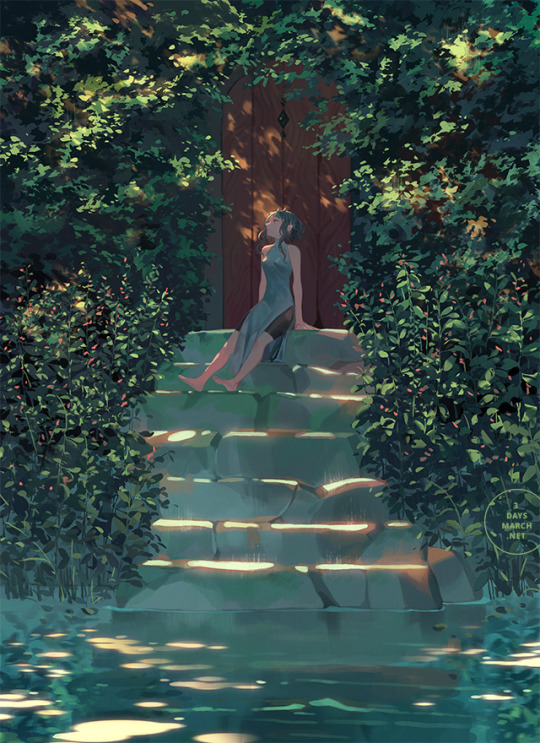
I drew this with an XP-Pen Artist Pro 24, which the team at XP-Pen kindly sent to me for review. I’ve had to opportunity to use this tablet on-and-off over the course of the past several weeks, and while there were a few issues my overall impression is positive.
Unboxing / Contents
Apart from the 24” display tablet itself, the package comes with the usual cabling peripherals, plus some bonus extras. If your machine supports a USB-C connection for display, you’ll only need the one cable (plus the power connection). Otherwise, there’s a HDMI and a USB-C to USB converter included as well.
The extras include: an additional stylus, a one-size-fits-all artist’s glove, and a microfiber cloth.
The container for the stylus twists open to reveal 8 extra stylus nibs. Its cap can also be removed to use as a stylus holder.
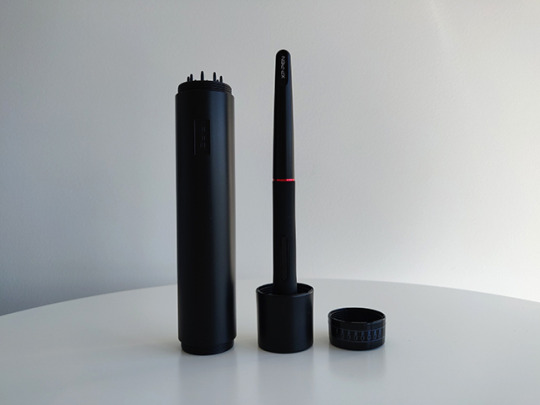
Driver (Installation & General Use)
There were a few issues with installation, mostly tied to interactions between the driver, Windows 10 and Windows Ink.
Initially, brush strokes were offset from the stylus’ point of contact with the screen by about 3-4 centimetres when attempting to draw in Photoshop CS6. Random straight strokes also occurred frequently. This same problem did not occur in MS Paint or Photoshop CC 2019. This was fixed by changing the UI scaling setting for the monitor in Windows settings from 125% (which was apparently the default) to 100%.
Initially, brush strokes had no pen pressure in Photoshop CC 2019. Photoshop CS6, on the other hand, did (but suffered from the previous offset problem). This was fixed by turning on the Windows Ink setting in the XP-Pen driver menu. So in other words: CC 2019 needs Windows Ink on to recognise pen pressure, while CS6 didn’t, but was affected by UI scaling.
Interestingly, if Windows Task Manager was in focus and Windows Ink was not enabled in driver settings, stylus input was not recognised at all. There may be other programs that have this issue, but this was the only one I encountered so far.
I will say that I’ve had many problems with Wacom drivers interacting badly with Windows Ink and other things in the past before, so these types of issues are not exclusive to the XP-Pen drivers.
I’m currently using driver version 3.0.5, a beta build that has a lovely UI; it’s clear and laid out well. I did also try version 1.6.4 initially, which was fine — the UI for that version was similar to the layout you find with Wacom drivers.
Apart from the issues during installation that required troubleshooting, I haven’t had many major complaints with the driver in day-to-day use, I do think that there are a few areas for improvement, however.
The driver stops working correctly each time the computer is set to sleep and woken up again. To fix this the driver must be exited from the system tray and then relaunched.
There also doesn’t seem to be a way to bind WIN+SHIFT+ARROW to any of the express keys. WIN+SHIFT+ARROW (left or right arrow) is the Windows shortcut to quickly move a focused window to another monitor, so it’s something I use a lot if I’m on a multi-monitor setup. Unfortunately, attempting to set this shortcut in the express keys menu will simply move the actual driver window over to the other monitor while the custom input is not properly recognised in the text field.
The driver does offer a “switch monitor” option for the express keys that when clicked will transfer your stylus input to another monitor, which is extremely useful.
Screen
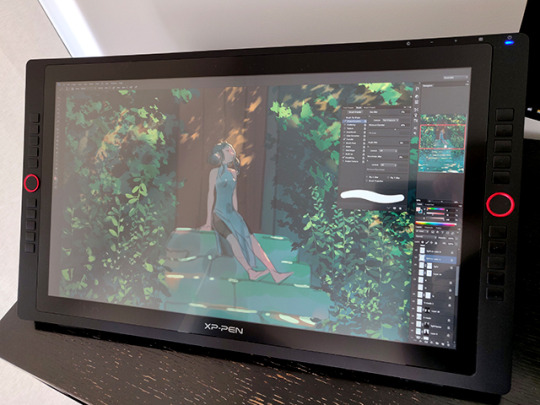
At 24” with a 2560x1440p QHD resolution, images are sharp and crisp even when viewed from a close range while drawing. Genuinely, it feels great to paint on based off this aspect alone.
The colour temperature is set to 6500K by default in the the driver settings. I think initially it felt just a touch too saturated, but overall I’m fairly happy with the colour display.
The monitor has touch-sensitive inputs on the top right corner: a -/+ for quickly adjusting the brightness, a menu for further settings, and power. I found myself using these to adjust the brightness throughout the day frequently. The power input requires a few seconds of continued contact from your finger to react, which prevents you from accidentally brushing it and turning the monitor on/off.
The monitor comes with a built-in stand. I found it easy to adjust to different viewing angles and also incredibly sturdy. I had no problems leaning on the monitor while drawing.
The monitor also comes with a pre-applied anti-glare screen protector. I wasn’t bothered by it and it seems to be holding out well after several weeks of use. I think the screen itself definitely needs the additional anti-glare, as being a display tablet means that it’s significantly more reflective than my main display.
Stylus
My first impression of the stylus was that it’s lighter in comparison to the Wacom styluses that I’m used to — there is very little to no weighting on the back end of the stylus, which makes it feel noticeably different when gripped. To be honest, though, I forgot about it when I was actually painting. Still, I would prefer a bit more weighting because I do think it makes the stylus more comfortable to hold overall for long periods of time.
There’s also no eraser nib, but I’ve personally never used those on Wacom tablets (I always use shortcuts to switch between brush and eraser instead) so this was a non-issue for me.
The two shortcut buttons on the side of the stylus sit quite flat to the surface, so I think they would be less likely to bother people who don’t use them. I use them a lot, however, and found that they were still easy to click despite being quite flat.
Unfortunately however I ran into a curious issue with using one of the stylus buttons to activate the eyedropper tool. When the “alt” key is mapped to one of the triggers on the stylus, activation of the eyedropper function in Photoshop (tested in both CS6 and CC 2019) is somewhat unreliable. That is, when the “alt” key is held down, the expected result is that once you tap the stylus on the canvas, a “mouse-click” will be triggered and the eyedropper will activate. While this works perfectly fine if you hold down “alt” from the keyboard (or hold down an “alt” that’s bound to one of the 20 express keys), when you hold “alt” from a stylus trigger I found that tapping quickly with the stylus only seemed to activate the eyedropper about 50% of the time. In order to activate it more reliably, I had to press harder and longer with the stylus, which can become tiring and slowed down my painting process. I also found that frequently, pressing down longer would lock me into the eyedropping function until I clicked the trigger key again.
After submitting feedback about this XP-Pen’s R&D department, I was informed that this issue occurs because the stylus is only able to send one message to the tablet at a time. Pressing “alt” on the stylus and trying to “click” at the same time counts as two messages, which may interact with each other unexpectedly. This is why it sometimes works and sometimes doesn’t.
The buttons seem to otherwise work completely fine for any other functions that don’t require the stylus to send two simultaneous messages, so unless you’re like me and like to bind “alt” to a stylus trigger, this won’t affect you.
Pen Pressure & Activation Force
Most current-gen tablets flash a big number for the pen pressure levels as a selling point. Having used tablets with 512, 2k, 4k and 8k levels of pressure sensitivity, I’d say I noticed the biggest difference when switching from 512 to 2k, but in my opinion beyond 2k the change is minimal and has no real impact on the way I draw. The XP-Pen Artist Pro 24 comes with 8192 levels of sensitivty, which is a very big number, but in practical application all I can say is that it works the way I expect it to and I don’t have any complaints regarding the transition between pressure levels on the default linear pressure curve.
More importantly I did notice that the IAF (initial activation force) was not as low as I would have liked. Very light input is not recognised, or only partially recognised before dropping off and on again. In a practical sense this doesn’t actually impact me through most of (perhaps 97%) of the painting process, but it did give me pause once in a while when I wanted to make a really light stroke and had to adjust my method. The drivers for this tablet do come with a pressure curve you can adjust to your preferences, so this can help a little, although after some tests I preferred to leave mine on the default setting.
Summary of Drawing Experience (tl;dr)
I think the mark of a good tool or piece of hardware is that it does not draw attention to itself during the course of its use. An ideal drawing experience allows me to be fully immersed in the act of drawing without having my focus shifted to dealing with the tool. With this in mind the XP-Pen Artist Pro performed very well for the most part, but was held back by a couple of issues.
Pros:
The monitor resolution honestly feels great to look at; the pixel density means that I can basically forget about pixels even with my face positioned closer to the screen.
The parallax between the tip of the stylus and the actual position of input was very minimal and basically not noticeable for me, especially after the simple calibration process offered by the driver.
At normal room temperature (say up to about mid-20’s celsius) the monitor screen stays impressively cool to the touch and I was never bothered by resting my drawing hand on its surface even when painting for long sessions.
The 20 express keys and 2 roller rings are extremely helpful and I actually found myself using all of them, despite initially thinking that I’d only need half of them. The keys are also comfortable and responsive to click (which sounds like it should obviously be so, but having used some Intuos iterations in the past which had some very annoying-to-click express keys, I don’t take this feature for granted anymore).
Cons:
The driver needs to be restarted everytime the computer wakes from sleep in order to work.
Higher IAF was noticeable when very light strokes were desirable. Also, the input will on rare occasions glitch by performing a completely straight max opacity + max brush size stroke. This seemed to happen primarily when I was trying to get light strokes to register. (It didn’t happen often enough to bother me much since it’s just a quick undo, but it did happen enough times that I noticed it.)
The issue with eyedropping using “alt” mapped to a stylus trigger as detailed above. Quite unlucky for someone like me who has over a decade of muscle memory for this particular mapping.
Overall, as I said at the beginning, my impression of the tablet is positive. While I think it has room for improvement when it comes to driver performance and the initial activation force especially, it also has a lot to offer at a highly competitive price point ($900USD at retail), and it would’ve been amazing if something like this had been available to me back when I first started digital painting. As I do enjoy using it for the most part I’ll probably continue to use it on-and-off in future.
848 notes
·
View notes
Note
I think it's the ironic fact that JTTW fans already know how DBK and Sun Wukong's friendship broke apart but are more curious on LMK versions of Sun Wukong and the Six Eared Macaque were friends alongside falling out.
HA! Well, while it often does seem that way, I'm going to go ahead and be a complete snob in a Journey to the West purist kind of way by wondering how many Six Eared Macaque fans would consider themselves more JTTW fans or more Monkie Kid fans, or if they feel they're a mix of both...
I've seen a lot of people argue that these two works of fiction are their own thing and that as such Monkie Kid (and associated fanworks) shouldn't be expected to follow the canon of JTTW, and fair enough for some parts. I've also, however, seen people who argue for this complete separation seeming to use it as an excuse to not acknowledge or learn about ANY original aspects of characters such as Sun Wukong and the Demon Bull King, or even very important deities such as Guanyin and the Jade Emperor, and who as such end up making some pretty gross generalizations/assumptions about them even though they are of great religious and cultural importance.
For example (and while I know a lot of the fun people get from fan works is in exaggerating certain traits), Sun Wukong seems to often be presented with an "inherently" evil/thoughtless/chaotic character, while his intelligence, deep love of his family, genuine efforts to become a better person, & many acts of saving lives, as presented in JTTW, aren't even mentioned. I feel like a lot of this is due to the way he acts in Monkie Kid (while I maintain that this version of Sun Wukong seems to be Bad End Monkey King, he does do a lot of deflecting his issues with a show of humor/a carefree attitude & does seem really bad at communicating due to a fear of making things worse). Even so, the popularity of Thoughtless/Evil/Selfish Sun Wukong that doesn’t really allow for any of the nuance or a display of his beneficial traits as shown in JTTW does make me wonder how many people have been exposed to a good translation of og classic Sun Wukong...As I've said before, I've noted that a number of Chinese people on this site have expressed frustration with the fact that a good chunk of the monkey king’s Western audience seems to be getting their impressions about Sun Wukong, the Demon Bull King, the Six Eared Macaque, etc. from some mix of Overly Sarcastic Productions, Monkie Kid, and social media instead of from at least a translation of the original text, and it is true that a LOT of the nuance of these work and these characters can be very easily lost, especially if your drawing your information of them primarily from a cartoony version of the original source.
That would be an interesting poll though...out of curiosity, how many of you fine folk have read the break-up & fight between Sun Wukong and the Demon Bull King either in the original text or in a translation, or is your exposure to them primarily through Monkie Kid?
Again, I need to make it clear that I'm not Chinese & didn't grow up with the story, but I will admit for my own part that reading the DBK/SWK break-up in the Yu translation actually made me more curious about how their dynamic is going to play out in Monkie Kid than I am curious about what's going to happen with Mr. Macaque.
This is primarily because besides SWK’s fight with Princess Iron Fan and DBK being given a LOT of page space in JTTW, there seems to have been some serious stuff that went down between the three of them in the events post-JTTW and pre-the main plot of Monkie Kid...the last we see of DBK in JTTW (if memory serves correctly) was him being hauled off by a host of heavenly warriors to be judged for his crimes of not giving SWK the palm leaf fan & also eating humans. When Monkie Kid starts, however, we are told that DBK had emerged “from the Netherworld” & immediately starts wrecking everything around him. What this suggests--if Monkie Kid is something of a fan continuation of JTTW--is that DBK ended up being executed by the heavenly forces, but managed to fight his way out of the underworld in a manner somewhat similar to SWK, who we are told he is equal in strength to in JTTW. In that beginning fight of Monkie Kid DBK is also shown as so enraged that he won’t stop his path of destruction until SWK buries him under a mountain for 500 years. It’s never said in the show, but--and this is important--this is basically exactly what Buddha did to SWK to start him on the path of atonement. So there seems to be some very intentional parallels between SWK’s havoc in heaven & DBK’s havoc on earth, which may suggest that one of the things Monkie Kid SWK really wants is for his former dear friend, his sworn brother, to find a way like him to be less violent and thus ultimately less vulnerable to destructive and self-destructive behavior, and that the way he tried to start this was by giving DBK the same treatment he got when he was a raging warlord.
We are furthermore told that it was right after DBK was sealed that SWK disappeared for all those centuries, and while the impulse may be to write it off as him just wanting to enjoy himself (given a lot of his behavior in the show’s timeline), given the indications that this SWK may be deeply depressed, I feel like the answer could be something a lot more tragic...there seem to be a number of clues in Monkie Kid that while the journey of JTTW happened, something made it end disastrously, with SWK either assuming or knowing that Zhu Bajie, Sha Wujing, Tang Sanzang, and Bai Longma are dead. And per JTTW, this wouldn’t be the first time that he’s experienced a horrific loss, given the war with heaven and the burning of Flower-Fruit Mountain. And then right after THAT, it seems DBK emerged from the underworld, and so Sun Wukong was put into a horrific position: either murder his sworn brother, or let him continue to rampage & harm and/or kill who knows how many humans. SWK ultimately gives up his staff to do the repeat of “500 years under a mountain in solitary confinement route,” which as per JTTW he considers better than the alternative, but he immediately follows that by exiling himself. In JTTW SWK is a really sociable person who makes friends wherever he goes, but man, for this SWK...his life must at that point just feel like one failure after another, that in spite of all his best efforts he wasn’t able to save anyone he really cared about, and now he just trapped someone who was so important to him under a mountain & fated him to suffer the same things he had when he was in that position. How much more does he have to hurt his fellow yaoguai? How many more times does he have to choose between yaoguai and humans, feeling like no matter what he decides it’s just going to result in pain for him and/or his loved ones? I can easily imagine super sociable & easily upset (he cries a LOT in JTTW) SWK feeling like after sealing DBK, he just can’t do this any more. He just...can’t.
This is all just speculation, but knowing the JTTW backstory between SWK and DBK does, at least for me, make their Monkie Kid relationship a lot more intriguing than it might be otherwise. Especially now that DBK seems to actually be making some small steps to quell his constant rage & lust for power. He even saves SWK and Qi Xiaotian from an explosion/nasty fall in the season 2 special! The Bull family weren’t really present in season 2, but I really hope they make a comeback in season 3 (if/when we get it) precisely because Red Son, Princess Iron Fan, and especially DBK have such an involved history with SWK. Plus it would be really fun to see two old warlords trying to awkwardly make amends with each other & struggle to be good teachers & positive role models to their student & son.
In any case I feel this potential is more interesting than whatever fanfic The Six Eared “I’mma Plagiarize The Demon Bull King’s Backstory Of Being Best Friends with Sun Wukong” Macaque is creating lol.
#monkie kid#journey to the west#lego monkie kid#lmk#lmk sun wukong#lmk dbk#lmk six eared macaque#anon answered
108 notes
·
View notes
Text
Your Content and Accessibility For the Blind
Hello everyone! I was thinking about accessibility and wanted to make a post to help creators. This is going to cover general accessibility for blind people interacting with your content. Some of it may be obvious to some and this is by no means comprehensive, so feel free to add anything you think of that is helpful. Also, I wanted to include some ideas for DeafBlind people, but I am not DeafBlind or D/deaf, so I simply listed some general accessibility ideas. If anyone has any other tips or things to consider, please add them in a comment or message and I’ll include it here.
Remember, blindness exists on a spectrum. This post will focus on making things accessible for totally blind people, although these tips can also be beneficial for people with residual vision who use screen readers to reduce eye strain, for small text, for clarity, etc. D/deafness and DeafBlindness are also on spectrums. Some DeafBlind people have some hearing, some vision, a little of both, or none of either. If someone asks you for better or different accessibility services for your content, listen and try to accommodate them as best you can. I have provided some links and resources here to attempt to explain accessibility for blind people, which will include blind people who are DeafBlind. The point is accessibility issues can come from both sides whether it be the audio or visual sides.
Some general helpful links:
AFB’s Advice for image descriptions here
Screen-readers here
Improving Accessibility for the DeafBlind community here
How DeafBlind People Use Technology and The Importance of Braille and Transcripts: Understanding Assistive Technology
Online Content:
GIFs, Pictures, Fan-art, PSA and info posts, Memes, Screenshots of Text Posts or Screenshots of Twitter Threads- Provide an image description on your original post! This is the best option, as you probably know your content best and what you wish to draw attention to. More importantly, every reblog will include an image description, which means the blind person doesn’t need to hunt for an image description in the reblogs! If you know more than one language, include image descriptions in those languages.
Note: Always include descriptions when you post images with or about blind people or characters. Particularly fan-art you made of blind characters. If you don’t, consider why and think about how it would feel to be shut out of something about yourself.
What should you include?
Write Image Description in brackets and include End of Image Description at the end for clarification. As for what you should describe, it depends on what the picture is. Include where it is from. For example, “a screenshot of a Twitter thread by BlindBetaIsAwesome”. Include the text and describe any GIFs or images it includes. Write everything out as they appear. Describe emojis as well. When writing out screen names or hashtags, capitalize the first letter of each word. Otherwise screen-readers read it oddly. For example instead of #accessibilityfortheblind try #AccessibilityForTheBlind. If you think someone will want to search a name, include a link.
You should describe what is important in the image, especially for conveying information or humor. General ideas include: image origin, who is in the image, what they’re doing, any relevant colors or clothing, objects they’re holding, their facial expression, any emojis, and any text in the image. Blind people do like to know about color. For NSFW stuff, include ‘NSFW’ at the start, but other than that, yes, blind people also generally like NSFW things described.
Fanfiction:
Generally, fanfic is very accessible to screen-readers and Braille Displays. However, there are a few ways you can make it more accessible.
Pictures: Include alt-text for any images you post such as artwork or character social media posts. Describe it like you would any other image. Alt-text is different from an image description because instead of a screen-reader saying “image” when it finds an image, it will describe the image. An image description is the text included beneath the picture that everyone can see. Including some kind of description, especially for plot-relevant images, can allow all blind readers to experience the fic.
Chat conversations: Again, for hashtags and screen names, capitalize the first letter of each word for the ease of screen-readers. For characters who don’t use capitalization much, you can add a hyphen between each word to make it easier to read like this: blind-beta-likes-fanfic-too.
Emojis: Screen readers can’t fully read emojis like this one that uses keyboard slashes and symbols to create an image ¯\_(ツ)_/¯ (image description: emoji of a person shrugging with both palms lifted upwards. End description.) However, they can read emojis that come on a phone such as 🧁which screen readers read as “cupcake”.
Podfics are also good for hearing people with no vision or reduced vision. Having a podfic with good quality (maybe one that can describe images found in the story) will reduce some of the issues listed here and give blind people another, fun way to interact with content. However, I would try to keep in mind the things I mentioned above for the sake of screen-readers and Braille Displays, which are particularly important for some DeafBlind people who may want to read your fanfic and may not be able to hear well enough to use a screen-reader.
Lastly, keep in mind that any kind of comic may be inaccessible to some blind people. Write with them in mind. Include a message at the start of the story, maybe that it contains material from the comic, graphic novel, or print cartoon. If you know of a comic dub, link to it. If there is none, include details in the story so that a non-manga or non-comic reader would be able to understand.
Web-Comics/Web-Graphic-Novels:
First, I did research and found a comic book store for the blind called Comics Empower. Unfortunately, when I click the link provided on Twitter and the articles I read, the site seems to be down.
However, this is about you all and sharing your comics with blind readers. You have a few options:
Alt-text. This is descriptions directly ‘inside’ the image, which is not visible to everyone. You can read about alt-text for comics specially here and you can read general info for alt-text for screen-readers and Braille Displays here.
Image descriptions. These are descriptions of each comic page (hopefully with a paragraph for each panel) that can be visible to anyone. You can describe your comic, who is in it, what they’re doing, and what they’re saying, probably beneath the image.
Comic Audio Performances. These are accessible to both blind and sighted audiences. These are videos using actors for the dialogue, sound effects, and moving comic panels. Pros for this style include increased viewership, increased accessibility for the blind, and perhaps more revenue if you have a way to monetize the content. Cons include that it is more work, could potentially cost money when hiring actors initially, may not be accessible to anyone with hearing loss, and may still require a bit of audio description for some panels that are hard to follow with only sound effects.
What can you do?
A few ideas I had were to use a combination of image descriptions and audio performances to make the comics accessible to a number of people who may be blind, or DeafBlind. Having options is helpful. For ther issue of some panels needing extra description in order to make sense, I thought of including time-stamps and descriptions in the description section, labeling it as image descriptions for the blind. Include dialogue for reference. Or an audio description could be added such as:
Audio narration: “Bee sits on a couch writing.”
Sound Effect of a purring cat.
Audio narration: “Blind Beta picks up an orange cat and puts him on the couch next to them.”
Dialogue: “I’m so glad I have a cat to cuddle with!”
I will touch on this in the video section, but while it is sadly not possible to add audio descriptions onto YouTube as of 2021, you can add them manually through websites you like YouDescribe. For your comics, I suggest, reading about YouDescribe, downloading the app, creating a narration transcript for your web comic performance, and posting the described audio performance onto YouDescribe. Post both versions as close to the same time as you can, and include a link to the described version in the YouTube description. A glance at YouDescribe will tell you not all videos are available with descriptions and not all blind people are aware of this service. Not all videos are searchable in their library either. However, it is an option I wanted to include.
You could also simply include the audio narration in your main YouTube video if you would like. Or any combination of my suggestions you feel comfortable with.
YouTube Videos/Video Clips:
I wanted to cover YouTube videos and video clips shared on websites like tumblr. For small clips, image descriptions and transcripts could probably be listed together. I have seen this done and it seems to help people.
Again, the original poster should post the description with the video. This is because they know the most important parts and because all reblogs of the post will include the description, so no one will have to hunt down a description that may not exist.
For the clip or clip compilation, mention where the clips come from, who is in them, and what they are doing. You could probably have a separate paragraph for each clip and include times-stamps if possible.
For videos you post on YouTube, descriptions can be very helpful! Unfortunately, YouTube does not support adding an audio description track at this time. Ideally, YouTube would have a description track one could turn on and off such as with subtitles. Until then, if you want to add a description, you should add one yourself when you post the video onto YouTube or any other website.
Before I get into how, let’s go over something else.
What videos need descriptions?
-Recipe videos - especially ones with only text. Ingredients, steps, measures, methods, any flourishes or special scenery (such as when shopping for ingredients) should be described. Blind people don’t just want you to read the recipe to them. They want to know what is happening in the video and how it is being done.
-Tutorials - These often contain a voice-over and accompanying images to demonstrate. A creator can opt to simply include more visual description along with the other information in the voice-over or add extra narration later (see the “How?” section below). For these videos, make sure to avoid or expand on any visually dependent parts such as “click here” or “fold here” or “when you finish, it should look like this”. Videos that contain only text and demonstration, however, will need a more traditional audio description the same as any other video.
-Silent aesthetic videos - Sometimes containing music or focusing on natural noise, these videos are usually vlogs with soothing activities or daily routines. They often show scenery, pretty things, or tours. Because these videos are silent, sometimes containing only text, they are not accessible. However, they can be easy to describe, perhaps in a soothing or educational fashion.
-Music videos - Because these videos are by nature visual, they may not be accessible. They may also have inconsistent, poor, or changing lighting for aesthetic purposes or set changes. This means audio descriptions would be helpful.
-Text-based videos - Obviously these are not accessible or may be difficult to read depending on font size, style, or background. For these, putting the text in the description may suffice. Label it so that blind people are aware they are getting the same material. If the text includes pictures or short clips, you could also simply include your own narration on the video itself or see the “How?” section below for another alternative.
-Game Play-Throughs - Games can sometimes be completely inaccessible pe very difficult depending on the person’s level of site. A lot of video games a not accessible or difficult to play, with quick-moving graphics, perhaps small text, or other difficulties. Because of this, blind people may enjoy game plays on YouTube for video games and mobile games.
-Skits or other performances - Think of these as Netflix shows with audio description tracks. Blind people may miss out on some visual humor, plot elements, or other fun visual aspects like costumes.
-Original Films, Animation, Clips From Shows - Again, think of it as any TV show that needs to description to cover visual aspects of what is happening. Scenery, characters, what they’re doing, any text, facial expressions, etc.
Pet videos- Because pets are cute and they should be described! Especially because these videos are sometimes hard to follow, such as a pet doing a trick.
How? How Do We Provide This?
There is always the option to add your own audio descriptions. However, that way confuse already-existing narration or may not be possible for already-published videos. You may also have trouble speaking and wish for someone else to provide audio descriptions. The video may be a music video or one you want to remain silent for the aesthetic. You may want to add a description to a video you enjoy that is not one you uploaded personally.
A free website and mobile app called YouDescribe can help with that. It allows people to add audio descriptions to videos on YouTube. You can even describe videos on a wishlist. Find out more here.
If you describe your video or have it described, be sure to link to the YouDescribe video in the description of your YouTube version so that people can find it easily, or note that it is available on YouDescribe.
Here is a link to the website
And a link to the app.
This site may be a bit too niche, but I figure if it helps one person, I’ll be happy. My entire blog is niche, when you think about it- targeting writers who specifically want to write and read about blind characters. It’ll be fine.
Keep in mind that audio descriptions may not be accessible to all DeafBlind people. An inclusive option could be to include a description under your video so people with Braille Displays can read it.
Print Books, Audiobooks, Large Print Books, or Braille Books?
Let’s get into something you writers might be interested in. Books! Let’s say you wrote a book with a blind character. How do you make sure it can be accessed by blind readers? You want to have a few options.
Print books - These are accessible to people with reduced vision. It is also possible to scan print books to read with voiceover, but I can’t imagine many people buying books simply to scan unless they borrowed/found it. So it could be an option, I suppose. Scanning books also takes time because you need to do each individual page.
Audiobooks - Audiobooks are great. They are accessible to blind people who can hear. They are cheaper to produce than Braille books, take up less space, and are better for the environment. They can be expensive when you buy them. Libraries have extensive collections now, however, because libraries don’t usually have any Braille books and very few large print books, not all blind people use them, even for digital access. However,many blind people love audiobooks so it a good way to make sure your content is accessible.
As of now, my library app is accessible with a screenreader, so reading audiobooks is possible. E-books are not currently accessible with a screen-reader on this particular app.
Make sure to release your print books and audiobooks at the same time or as soon as possible. It isn’t fair for blind people to have to wait, although there are cases where not having an audiobook is understandable. Keep in mind that the less options you have, the less accessible your content will be.
Large Print Books - I used to get large print books myself. I would say it is less likely publishers will want to publish large print books because they are, of course, larger and take up more space. (Not as much as Braille books, but we’ll get into that.) As you may assume, they are also less popular with readers. Publishers make exceptions for textbooks, so if you are making a textbook or an educational book, particularly one with drawings, publishers might allow it. They also might consider making large print editions of children’s books. Large print books can sometimes be found at libraries, although they are usually crammed into their own limited section. That shows how rare it is for large print books to be printed compared to regular-sized books. I have an extra note about this in the children’s book section, but for the most part, I think you can get away with not having a large print edition of your book.
Braille Books - I should you one doesn’t just make a Braille book. Feelings toward them are generally complicated. They can wear down over time, cost a lot, and take up a lot of space. One volume of a book is several volumes of Braille books. Libraries don’t generally have them- you have to request them from various places like The National Library Service for the Blind (NLS). For more information about obtaining or borrowing Braille books, look here.
Braille Books have largely been replaced by refreshable Braille displays and audiobooks. However, they are still important. They can also help DeafBlind people, if a book cannot be read on a Braille display (see the section on e-books below). My suggestion would be to skip Braille books unless you are writing for children (see the Children’s Books section) or your book contains many diagrams that need to be embossed.
Children’s Books -
I wanted to briefly discuss children’s books. With children’s books, you will, of course, want to have a print book and an audiobook available, perhaps even someone reading the book on YouTube. If the book has pictures, descriptions of the pictures would be nice. This is also where I think large print and Braille books may be not only possible or more likely, but important. Children are just learning to read and will continue to explore a love for reading. Therefore, a lack of reading material can be challenging.
If possible, you may want to consider asking your publisher if large print or Braille versions are possible. While websites are available so that children can get books, you may want to ask for your book to be published in these formats if your story has a blind MC.
Braille literacy is declining in the blind community, with children (and frankly many others) choosing to use VoiceOver and audiobooks to read rather than Braille. Being able to read helps reinforce spelling, grammar, meaning in ways that are not possible with having things read to you. That said, children should also be encouraged to learn technology and use audiobooks when they feel comfortable.
If you are publishing a children’s book, particularly with a blind MC, consider what your options are for increasing accessibility.
E-Books:
This is one of the more accessible options, as it can be read with a screen-reader or Braille display. E-books are also common enough that they are released at the same time as print books. The text can usually be adjusted and readers usually have a Search feature. However, accessibility is still a problem with e-books. While authors cannot fix this, they should be aware of it. You can read about accessibility issues here.
-
I hope all this helped somewhat. I provide sensitivity reading for blind characters for anyone who is interested.
398 notes
·
View notes
Text
One Year Anniversary: Top 12 Ducktales Episodes!
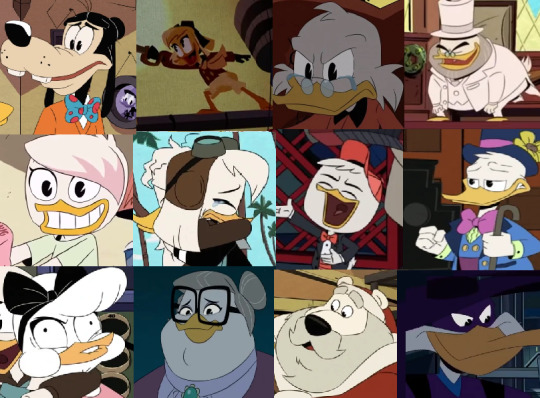
Happy anniversary all you happy people! Yes it was one year ago today I started reviewing animation and it’s been a ride to be sure. I’d always WANTED to be a reviewer: I love going on and on about stuff I love, really digging into it and picking it apart... but I could never get started. I tried youtube but I didn’t have the money for the equipment nor a proper shooting space to record, so my efforts.. were not great. And while I TRIED text reviews, my own looming pile of self hatred meant every attempt I made was shot down when it got hard as me not being good enough.
But one year ago I finally got past that. I’d already been reviewing a bit, doing invididual issues of comics... but got way in over my head trying to do the current line of X-Men comics as it came out, and wisely bowed out of that. But that left a gap: I had nothing to cover week to week and with a demanding new job, I drifted into just doing in charcter chats, little fan fictions script styles. Not bad work, I should do some more at some point and I even got a comissoin once in a while, but nothing I could really live on and not what I wanted to do with my life.
Enter Ducktales. I’d always WANTED to review the show.. and when the double premire happened, I decided fuck it, and put up my thoughts. And then decided.. hey maybe I can do this every week.. and slowly.. my work evolved, getting better and better, getting more and more likes. I picked up Amphibia when that came by week to week.
And eventually.. this went from a hobby, if one I was passionate about to a career. Not a largely paying one, as only one person was really intrested in paying me for it, friend of the blog and our fincial backer @weirdkev27, but .. it’s money and i’m now making about 30 dollars a month due to a comination of comissions and patreon. Other contributers are always welcome mind you, my patreon is here if your curious and comissions are 5 dollars an episode, but i’ts just nice to have money coming in. To have gone from simply WANTING to review things and make a living off it.. to simply doing it.
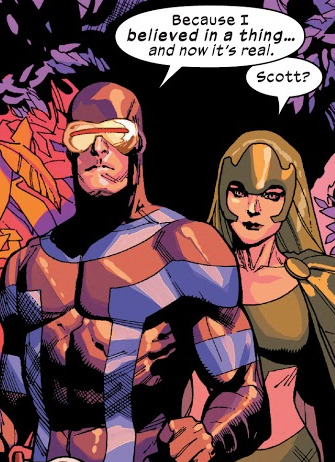
And it’s been one hell of a year.. and not just because 2020 felt like hell or 2021 began with a full on insurrection. I feel like i’ve acomplished a lot in the year i’ve been doing this: I finished what I started with Ducktales season 3, getting better and better as I went. And I didn’t stop there with ducks: I started covering what brought me to Ducks in the first place, the Life and Times of Scrooge McDuck, and while that retrospective has slid a bit on the schedule, I intend to get it back on track this month. I reviewed a bunch of Darkwing Duck episodes leading up to the Just Us Justice Ducks.. chronologically anyway. The actual airing order reads like someone took 50 issues of a comic, made it rain with them, then just started reading whatever ones they picked up randomly. I also covered some of Duck Master Carl Barks work with the classics Night on Bear Mountain, A Christmas for Shacktown and Back to the Klondike, with more to come.
And the Duck didn’t stop at just reviews I did on my own: Kev comissioned two MASSIVE retrospectives from me: My first for him was Ride of the Three Caballleros where in just a few short months I covered the boys entire televisied careers together from the movie, to house of mouse, to mickey and the roadster racers, to ducktales (again) and finishing with the wonderful Legend of the Three Caballeros. It has probably the worst Daisy imaginable, but otherwise is really excellent and i’m glad I finally watched it. I also covered Don Rosa’s two stories with the boys as part of it. It was a fun ride and I enjoyed every minute of it... okay most of them again Three Cabs Daisy is the worst. And once that finished Kev started up another idea: Shadow Into Light: a look at Lena’s character arc from start to finish that has gone on to be my most popular series on this blog, and that finishes next week. And there’s more to come as after that there’s a short breather with a look at Lilo and Stitch’s crossover episodes.. folllowed by me looking at all three of season 2′s ducktales arcs. And I fully intend to have covered every episode of the series by this time next year, so stay tuned.
Outside of ducks though I didn’t slow down. I restarted my Tom Lucitor retrospective, covering what i feel to be one of Star Vs’ two best characters, tied with eclipsa, and my personal faviorite as he redeemeed himself, found love and I bitched a lot about the horrible directions the series took and probabably will more as that’s still not done yet. I did what I always wanted to do and started looks at some of my faviorite comics ever, starting with Life and Times and adding in New X-Men and Scott PIlgrim. I also threw in the awesome comic Blacksad. I did pride month for the first time and not only came out publicly, but also did two whole arcs i’m proud of with The Saluna episodes of Loud house and the rednid episodes of OK KO, and generally just had myself a good old fashioned time as an out bi man reviewing childrens cartoons.
I started Season 2 of amphibia with it’s lows of an endlesss road trip and highs of adding Marcy to the cast and giving us more of the silky voiced keith david. And finally Patreon wise Kev’s taken me on a hell o fa journey: In addition to the restrospectives i’ve covered some additional darkwing duck, and a simpsons homage to the duck comics... but also got a bit weird and obscure with detours like the lost animnaics sucessor Histeria, the apocalyptic comedy where Santa dosen’t know how doors work Whoops! and the adventures of Santa’s bratty teen daughter jingle belle. In short.. it’s been a long year but damn has it been fun and there’s more to come. I’d like to thank all of you for reading, thank my Patreons Kev and Emma for supporting me, and thank my family for doing the same. So with that out of the way, I figured the best way to celebrate was to do something i’ve been wanting to do for a long time, something honoring the show that gave me this calling in the first place. And with Season 3 sadly being the last, and enough weeks having passed for me to digest it between the finale and today, I could think of nothing better than my top 12 episodes of Ducktales.
Ducktales is one of the best cartoons of the 2010′s. Brilliantly taking EVERYTHING that had come before, the comics, the original cartoon and every bit of duck media period to craft a masterful, unique and wonderful reboot. It was funny, it was insane, and it had damn good character arcs. By the end every member of the main cast along with major supporting cast members like Fenton, Drake and especially Lena, had changed and signifigantly at that. The show was everything I could’ve dreamed of and more and I miss it terribly, hoping DIsney will do a revivial movie at some point. For now though, Frank and Matt’s run on ducktales, as they called it and I do too since i’m a massive comic book nerd, it’s time to look back on my favorite tales of ducks. So grab your sharks, your number one dimes and your friendship cakes with clear gay undertones and join me under the cut as I celebrate one of my faviorite shows and my anniversary in the best way possible.
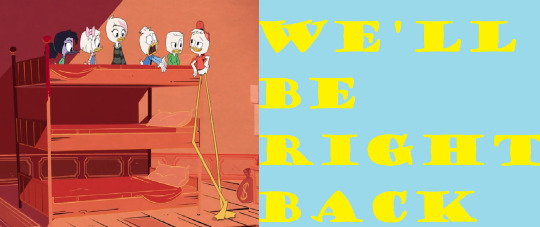
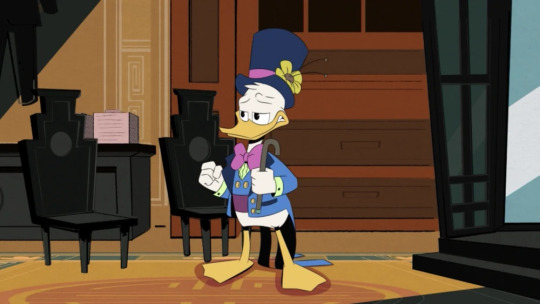
12. House of the Lucky Gander!
So as i’ve gone on about before and no doubt will again, Donald kinda got the short end of the stick in season 1. While Frank and Matt had good story intentions, keeping Donald away from adventure since he had no interest in it, in practice it meant a beloved Disney Icon who they and disney HEAVILY promoted as part of the series and whose being here this go round was a big draw for fans of the comics.... was only in a quarter of the season and only got TWO plots centered around him in 23 episodes, with only one being the main plot of the episode. The PIlot and Finale both centered around the family more as a whole if your curious how I counted those so while he got plenty of focus in both, it’s still not a day in the limelight sort of thing.
But unusually for Donald, he lucked out as his one big starring role for Season 1 was both one of my faviorites and one of Season 1′s most inventive outings. A lot of the episodes enegy comes from a one two punch of a great guest star and one of the series best settings. The guest star is of course everyone’s faviorite overly lucky himbo Gladstone Gander. The show adapted the prick perfectly: The original Gladstone from the comics.. was the worst asshole imaginable, utterly insufferable. And for a villian, and Donald’s rival, that’s all well and good.. but his super luck meant he RARELY , if ever, suffered any consequences for being just...
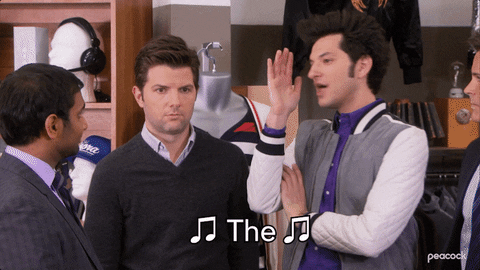
The 87 series simply made him nicer, while Going Quackers simply removed his luck. No adaptation really got how to make this fucker work.. until this one. Here Frank split the diffrence: Gladstone is still smug.. but he’s no longer actively malicious. While he is an insensitive prick to Donald in this one, unlike the comics he’s not constantly bragging about his luck or how great he is or actively BAITING Donald to fight with him or trying to ruin his relationship or a million other reasons he sucks and I hate him.
This version by contrast... is generous. He’s not the most empathetic, because he doesn’t get how life works, but he does share the riches of the casnio with everyone and in a cameo appearance in “Treasure of the Found Lamp” gladly offers his nephews some diamonds. He’s got a nice surface level charm to him that makes you understand why people like him.. but it’s also clear ther’es nothing UNDER that of value, making you equally understand why Scrooge and Donald hate him. Gladstone in this reboot is a perfect example of why we need reboots or new adaptations in the first place: Because sometimes the original got something wrong or something can be done much better by the new writers.
He’s perfectly paired with the setting: The House of Lucky Fortune, a mystical casino with an East Asian astatic based in the country of Macaw and provides two great plots. Donald’s really highlights his character: His understandable jealousy at gladstone earning the boys love through nothing while he struggles to make a living for them, and how he feels like a looser and like Gladstone is simply showing that off instead of just not knowing what empathy is. Having Louie be the one to bond with Gladstone was also just pitch pefefct, as is showing some depth for the boy by having himr ealize his hero is an asshole and be the one to help donald in the end.
The other plot is just pure joy though and is where the setting REALLY shines: Scrooge and the rest of the kids try to leave.. but can’t find the exit. This is where the creative part comes in: The Casino simply morphs to keep people trapped, and caters to them, giving them whatever they want to keep them trapped. In the cases of the kids it’s all hilarious and adorably in character: Huey becomes entranced by a fancy water show, in one of his best bits of the season, Dewey gets a pet tiger who sadly did not come home with him and Webby gets to live the dream we’ve all had of stuffing her face directly in a choclate fountain. Scrooge’s escape is likewise clever: He simply prepares to get a room.. then books it as the check in desk is ALWAYS near the front.
We then find out Gladston’es trapped get the whole mystical contest with absolutely gorgeous animation, i’ll talk about it in full some time but this episode is just a treat to watch, has a great arc for donald and had some memorable gags. I can’t help but smile when I watch it.
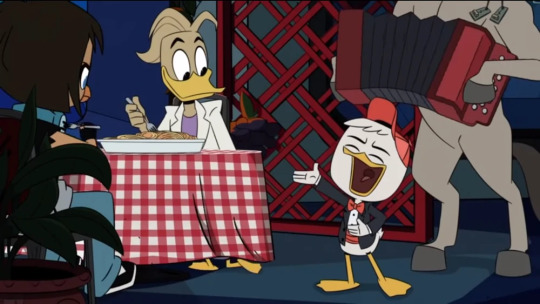
11. The Dangerous Chemistry of Gandra Dee! As I mentioned before i’m a superhero nerd so naturally Fenton was one of my faviorite parts of the show. Frank and Matt were just damn good at crafting superhero stories, and like gladstone improved fenton turning him from an awkward donald stand in to an awkward peter parker-esque science nerd who just wants to be a good person and the best hero he can be. He got into science not just because he thinks it’s neat, but because he honestly wants to help people and you can’t help but foot for him whenever he pops up. Lin Manuel Miranda is a large reason for that, bringing his incomparable a-game to the character. While we sadly didn’t get a ton of gizmoduck focused episodes, the fatct we got AS MANY as we did and that Lin didn’t drop out for a minute even with his busy schedule was a miracle and I’m acknowledging that.
As for why this one, I feel it builds brilliantly on the previous Fentoncentric episode Who Is Gizmoduck?! which just BARELY didn’t make this list and uses the fact we haven’t seen fenton in a while as both a plot point and to move some things forward without having to spend screentime they clearly didn’t have. By having Fenton be just burnt out on superheroics it finds a way to both explain where he’s been, he’s been busy with his new job, and give us an interesting angle to the old “superhero is tired of the life” thing. He never once complains about saving people or stuff... it’s just like any job it gets tiring after a while. As someone who has his dream job but has struggled with it from time to time, I vastly relate.
Though while I love my boy and Lin is game as always, the episodes real MVP is my other boy Huey. The episode has moved Huey up from being simply Fenton’s fanboy to being his best friend, and adorable as hell relationship. The two clearly respect and appricate each other and Huey is looking out for his buddy the whole episode. His love of love is also just really cute. Added in the mix is Webby, who in one of my faviorite gags of the series, finds out Fenton is Gizmoduck because Huey is incredibly and insanely blatant with his unecessary coverup. But she of course is game to help while Fenton is trying to play it casual. We also just get a waterfall of great gags as everyone overdoes it wingmanning for fenton: Huey sets up an itallian bistro and tries to purposfully create a lady and the tramp situation, and sings opera (With Manny on acordian), the wonderfully 80′s suit from Fenton’s dad his mom gives him to wear, and Launchpad, who gives us a tremendous list of his exes, and plays my favorite song of the series: It’s a Date, a micheal mcdonnel riff.
This episode also wisely ups Mark’s Beaks game as Fenton’s arch enemy, still keeping him hilaroius, with the guy acting like a bored teenager and guzzling so much nanite jucie he turns into a hulk, as well as said hulk mode leading to a ton of great gags from kidnapping the children (”I got your kids.. are they your kids? I don’t know how this family works), to “take that coach dad” to eating a pie with tins and all and wondering about said tins. But he’s an actual threat now, taking on fenton in one hell of a fight, and having an utterly transcendent scene where he hacks his way past gyro’s security while dancing.. and dabbing because of course he does. It’s a fun, well done character piece that’s mostly here for i’ts laugh but Fenton’s struggle with Gizmo overtaking his life, and finding out someone he truly hit it off iwth only wanted him for that.. it’s really good stuff and Lin’s delivery after Fenton finds out, the pure pain and betryal in his voice, is just excellent. Also that opera scene is poetry.

10. Quack Pack!
One of the episodes that started my career naturally landed here. Not for that reason though: Quack Pack is a fun riff on sitcoms, specifically the tgif ones of the 90′s that Disney Afternoon Kids no doubt also watched, the kinds Disney Channel still makes today, and most importanly the kind the Disney Afternoon itself made like Goof Troop and well... Quack Pack.
Riffs on sitcoms are nothing new and the last year has been FULL of them. 2020 gave us this episode, Beef House and the wonderful “The Perfect House” episode of Close Enough, and this year gave us WandaVision, my second favorite MCU project so far, right behind Black Panther, which used the sitcom deconstruction to create one hell of a character study.
So you’d think with a year having passed and this concept happening as an entire mini series would dull this one.. but no. it’s still damn funny, having fun at the cliches while, again like WandaVision, having one of the main cast be responsible by accident but go along with it. The episode pivots from glorious affectionate parody of cheesy sitcoms, to that plus horrifying “Humans”, and a character piece for Donald. This brings Donald’s hatred and fed up ness with adventure to a head revealing his fondest wish is just to have a normal life and not loose anyone again.
It takes one of his best friends to snap him out of it. Look Goofy is my second faviorite of the sensational seven, an episode with him was already an easy sell for me.. but the episode uses him really well. First for laughs as he’s gentically dispositioned to be a perfect sitcom neighbor.. but also for heart. With his family preoccupied and a bit hurt, i’ts Goofy who cuts to the heart of the issue, pointing out NO ONE is normal and even his normal domestic life raising Max, who we see go to prom with roxanne eeeeee, has all sorts of chaos. Normal is what you make of it and pining for some ideal that will never happen was just tearing donald apart piece by piece and by letting go of that.. he finally begins to grow as a person throughout the season. It’s also a great thematic tie in to the season’s overall plot with Bradford and what Makes donald, despite also disliking the chaos his family gets into, different. Donald accepted it and grew as a person.. Bradford clung to his hate and it ate him alive. Or turned him into a non-sapient kind of vulture. Before I close this part out Jaleel White is also excellent and I wish eh’d get back into voice acting. He’s so freaking good at it. Seriously man i’d love to see him and ben in a sonic property together as a mythology gag. Same with Jims cummings and carey. Just think about it whoever owns the sonic movies.. think about it.
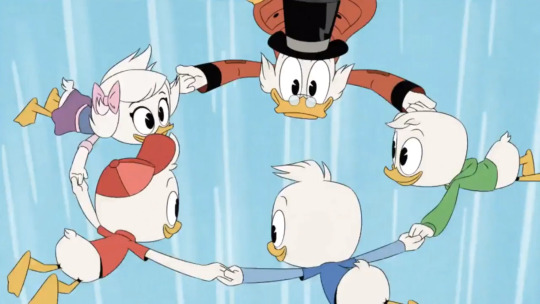
9. The Last Adventure!
Look I knew this was coming, you knew this was coming. But it had to be on here. The Last Adventure is not perfect: The lack of a build up episode like the previous two finales had really hurt this one: even at about 70 minutes, it still feels rushed in places and Huey, one of hte main characters of the season, dosen’t feel like he has a full payoff to his character like Dewey and Louie got.
But despite those flaws.. this episode is just a damn good ending. Almost everyone gets a big moment paying off their character arc, everyone in the party that comes to rescue webby and huey, along with the two themselves, gets a moment to show off, and everything comes together to give us one last epic sendoff. There’s just moment stacked on moment stacked on moment from Launchpads heroic second wind and donning of the gizmoduck armor, to Webby’s tearful confrontation with Beakley, to Huey using the greatest adventure of all line to foil bradford in one of the most deligfhully nuts moments of the series, I could go on for days with just how triumphant this finale felt. While it left a lot of doors open.. that feels like part of the design. It’s the end of the fight with FOWL.. but our heroes will never stop adventuring, never stop going and never stop being in our hearts and the curtain call at the end is now my faviorite bit of end credits ever, perfectly giving the main cast and friends one last chance to take a bow in their own unique ways. I will always miss this show but I will never be disapointed by the note it went out on.
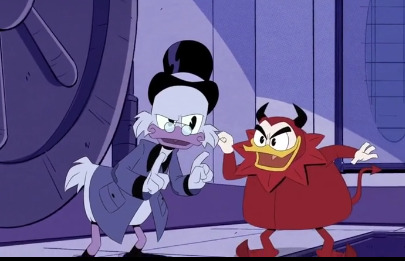
8. The 87 Cent Solution!
Look some episodes are show stoppers, some are heartfelt tearjerkers, some are all this and more.. and some episodes are just clever and hilarious. The 87 Solution is the second funniest episode of Ducktales with me and my go to episode when watching the show. It’s just pure fun and with a clever premise: Scrooge notices 87 cents have gone missing, and already coming down with a cold, goes mad with paranoia as the kids slowly don face masks, something that has become even eeerier given everything, one by one realizing he needs to stop.
While David Tennant is an EXCELLENT dramatic actor, his comedy timing is really something that shoudln’t be ignored and i’ts on full display here as his performance gets more and more deranged, to thep oint he thinks an 8th dimensional imp is repsonsible. He nicely balances the disturbing side of Scrooge’s paranoia, his distancing from his family, with plenty of great gags about it too, the standout being when he offers 2 million dollars to whoever took the money like he’s publicly appeasing kidnappers. It’s fucking brilliant.
But while David is awesome as ever what really, truly makes the episode is my boy, one of my faviorite characters on the show if not my single faviriote FLINTHEART GLOMGOLD. Keith Ferguson is ALWAYS a dream as the character but this is his best performance by far. Part of this is the addition of Zan Owlson, Kev who I mentioned earlier’s faviorite Ducktales character. She’s not only throughly likeable in her own right, but provides the one thing Flinty was missing; a straight man.. or woman in this case. Scrooge wasn’t TERRIBLE in the roll, but can easily step away from his shit or foil it. Owlson has to put up with Glomgold’s nonsense while desperatly trying to stop him from undoing all her hard work with sheer force of jackass. The two jut play off each other brilliantly, Glomgold not getting sh’es not his employee but his equal and Owlson constnatly snarking at him.
And of course both things hit their peak in the climax with the family staging a fake funeral (Though no one told donald it was fake), and we get the funniest scene in the entire fucking show as Glomgold burts in in a white suit, money shades and full dance number to “All I Do Is Win’, which when first watching this I was convinced the song was somehow accidnetly on in the background but nope. They got it after using it in the test phase and the scene is better for it. Glomgold twerking on Scrooge’s casket, trying to get on it to dance, and having to be placated like ac hild is the icing on this very rich cake
And the reveal scene is also gold as Glomgold gets into a YEARLONG staring contest with a baby, fails to steal more than the 87 cents and, in my faviorite touch, put on an imp costume just to make scrooge seem crazier... then keeps the damn thing on the rest of the time for no explicable reason. The episode is the show at it’s comedic peak while giving Glomgold a chance to be a genuine threat and that’s Glomgood.
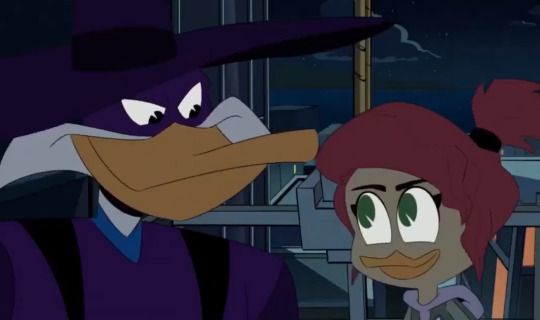
7. Let’s Get Dangerous!
Frank’s Rebooted Version of Darkwing Duck is probably his greatest achivment with the show. While this show is a team effort, something I slowly realized as I reviewed the show, it’s very clear from the way he talks, how well he knows the show and how much effort was put into porting Darkwing into the reboot that this was his baby. While redefining ducktales for the 2010′s was clearly a huge dream of his... doing the same for the master of suprise was an even bigger goal. And as a huge fan of superheroes i’ve seen my fair share of half assed takes on laired and complex characters. The XCU alone is one giant grab bag of missed opportunities for me.
So i’ts no exageration when I tell you Frank.. nailed it. In one of the most brilliant moves i’ve seen for a superhero work Frank worked his love of the show into the reboot.. by having Darkwing have been a show, one Launchpad loved.. and so did Drake, who was inspried by the show to become an inspriation himself and while his attempt to do that through a zack snydery reboot failed, Launchpad encouraged him to do it for real. Drake was still himself, but the meta aspect and the toning down of some of darkwing’s more obnoxious traits that didn’t work in a universe that, while patently rediciulous still took it’s characters seriously, he made a BETTER version of the character.
This is where all that comes to it’s peak, and hoppefully convinced Disney to let Frank , and possibly matt, run the reboot. And no, even if Point Grey is producing that dosen’t stop that: Thanks to Invincible i’ve now realized that Seth and his friend Evan producing the show dosen’t mean it’ll be RAN by them, nor unrelated to this. It just means their helping make it and if anything given how lush and gorgeous invincible’s animation is, it’s a VERY good sign their helping out with it if it’s true.
But wether this versoin continues or not, Frank gave it his best shot. Part of his diffrent angle is having Drake as a rookie here and as such here we see him truly struggle: he’s had his origin, he ahs the cape, he has the gadgets (in a brilliant turn thanks to fenton, who he actually likes... but is so far the ONLY person to not get he’s Gizmoduck), and the city.. but no crime to fight and no real idea how to go about his lifelong dream. The events of the episode slowly shape him: WHile he already had the spirit for darkwing, never giving up, looking good in a cape etc, this episode gives him the heart the same way it gave his original it: With Gosalyn. Dimantopolis and Beatriz just play off each other perfectly, as the two go from neimies to slowly bonding as Drake realizes this kid needs him and that he needs to fight for more than just filing the ohle inside, and goes to hell and back to help her get her grandpa back, with one of the best moments of the episode to me being when Launchpad helps her realize how hard he’s been working at it, an exausted drake refusing to acccept that he can’t get her grandpa back because he promised. He grows from simply trying to live the dream.. to surpassing the original. We also see more from Launchpad, who grows into his new family and helps push his boyfriend and newa dopted daughter in the right directions. The episode really evolves these characters from the simple disney afternoon versions, who while awesome were made into fully fleshed out characters. Gosalyn still has her edge but now has a hard lesson to learn about doing the right thing, forced to give up someone she loves for the greater good but finding a new family in the process.
Part of what makes the episode work though as while it is funcitonally one big darkwing duck reboot pilot that’s awesome, heartrending and a joy to watch... it’s still a ducktales episode in parts without either part hurting each other. Huey plays a vital role, figuring the ramrod is too good to be true.. and discovering just how it is, then when captured, slowly unravling why Bradford’s there and being at least in part responsible for outing him as a FOWL agent. While this is largely Drakes story the rest of the cast is still vital to it: Scrooge trusting in huey, Louie serving as his logical counter and Dewey meanwhile bonding with team darkwing and helping Gosalyn, knowing exactly where she’s been and providing a nice foil. The episode is just one long and impressive love letter to the original show while creating it’s own thing and that’s really this reboot in a nutshell. It also has some of the best fights of the series, with the first fight between darkwing and bulba, where our hero, unlike his original counterpart, easily troucnes bulba using his speed and skill, is the standout.

6. Woo-Ooo!
I covered this one recently so I won’t go on for too long.. but I will say I hold this one up as the gold standard for first episodes. In one hour, hell even in jus the first half we get a sense of the whole cast, the tone of the show, and the world we’ve been thrust into. It gets all the table setting out of the way by weaving it into a compelling story of Scrooge getting back in the game, finding a reason to get back to what he does best in those he loves most and setting up the season long arc effortlessly in the process. The worst I can say about the episode is it sets the bar a bit high for Season 1 and a lot of the first half really struggled to reach these heights. This episode is a masterwork and the perfect showcase for what the series would be at it’s height.

5. Moonvasion!
Speaking of Golden Standards, Moonvasion is one of the best season finale’s i’ve seen. it’s not THE best.. but that’s a really high bar to clear and that spots currently taken in my heart by “The Crossroads of Destiny” from Avatar the Last Airbender. But while not the best of it’s kind, it’s sitll the best the series put out and is an utterly satisfying epic that ties up season 2.
While I love the Last Adventure, it had a LOT to tie up and was really hampered by having to do all of that with no direct lead in. Moonvasion by contrast hits the ground running with the Moonlanders arriving on earth and all hell breaking loose, and the episode itself breaking into two stellar plots. Scrooge leading an army of every ally he has against the invaders, and Della seemingly going for reinforcements.. but really just trying to keep the kids safe from it, to their anger once they find out.
Both sides end up going badly: Scrooge looses most of his army as Lunaris was one step ahead of him and is left iwth Beakly and Launchpad, while Della ends up marooned.. and finds Donald. The reunion between the two is the highlight of the special, as the two argue as you’d expect (And Dewey cutting in seemingly to stop it.. only to rant at Donald for costing him “ten years of turbo” is the best gag of the episode), before embracing.
Our heroes naturally find ways to bounce back though. Louie, capping off his growth for the season, convinces his mom they can’t just hide.. and in the second best scene of the episode sings the lullabye she wrote.. one Donald sung them every night
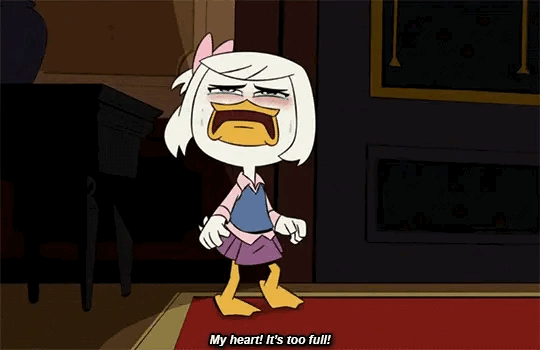
And no sooner than Della gets her step back and realizes that dangerous or not she and her newly reunited family have to get back in there, do the cousins show up on Fethry’s giant shrimp/girlfriend Mitzi, and our heroes head back.
Scrooge’s plot hits i’ts peak though as he’s forced to accept the help of an unlikely and unwelcome ally: Glomgold, who turns out to be exactly what they need: While his plan is as stupid, short sighted and insane as you’d expect, complete with forcing Scrooge to dress up as santa just to piss him off and dressing his sharks in parkas (”I call them sharkas”), the sheer lonacy throws Lunaris off as he dosen’t know how to deal with this and Glomgold not only gets the better of him but gets his company back as part of his scheme. “You were prepared for our best but not our dumbest!” “And i’m the dumbest theirs ever been! Muahahahaha! Wait...”
And of course our other heroes arrive just in time to save things.. and the episode still manages to pull off what many works struggle to, something tha’ts very hard to: a SECOND climax. Lunaris decides to just say fuck it and blow up the earth and i’ts up to our core family to kick his ass in space. Epic space battles, Della’s girlfriend meeting the family and more insues and an emotoinal, action packed and fully satisfying finale is had by all... and it’s all topped with one of the best sequel hooks i’ve ever seen as FOWL makes themselves known to us.. and prepares to strike.

4. How Santa Stole Christmas! This one will also be short as i’ve talked about this one.. a lottttt. The initial review, my best christmas specials list and my best of 2020 list. I stand by all of that: this is a unique and wonderful christmas special, i’ll be watching it every year, and i’ts full of charm, humor and gay subtext. In short it’s this series but on christmas footing.
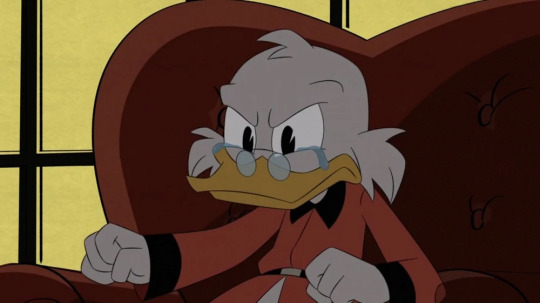
3. Last Crash of the Sunchaser!
Another one I covered very recently, this episode is a master piece of suspense, slowly building tension as our heroes get closer and closer to the truth about Della.. and to death, the simple but deadly stakes making this an absolute nailbiter from start to finish. This is some of the series best pacing bar none... but what seals it is the ending: the masterful flashback finally explaning whatever happened to Della duck, our heroes lashing out at each other.. all cumilating in the best Scene of the show. I said it might be in the review but no I can confirm: Scrooge bitterly ruminating over things while we find out just how much he’s lost... ending with him tearfully and angrily sitting once again alone in one hell of a powerful shot echoing Scrooge’s first apperance. Damn fine stuff.
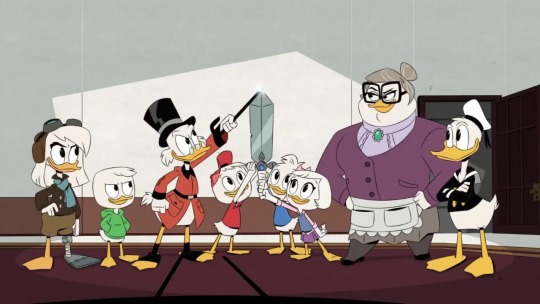
2. Escape from The Impossbin Only one episode not only matches Last Crash in mounting tension and atmosphere but suprasses it. With FOWL and Bradford’s true nature now out in the wind, this episode uses that to create tension and rattles it’s two most unshakable characters: SCrooge’s normal boundless confidence is shot, not sure he can win this time against an opponent who knows him as well as he knows himself while Beakly slowly unravels, pitting Webby against the boys.. and pitting herself against Webby when Webby sees her terroizing them is only dividing them. Both plots start out funny enough but slowly escalate in tension and stakes until by the end your on the edge of your seat. The Beakly plot is the standout of the two, giving Bentina the starring role she badly needed, having gotten even better in light of the finale. Everyone is at the top of their game and everything builds up to one hell of a twist ending and one hell of a badass boast from our heroes: Their down.. but their far from out and this is far from over.
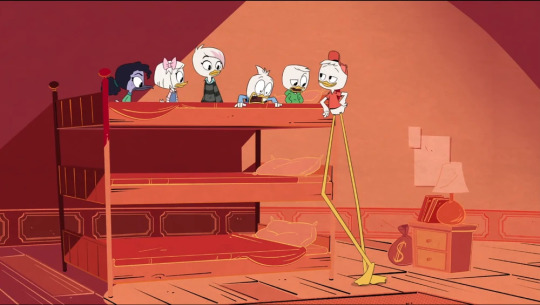
1. Nightmare On Kimotor Hill!
I”ll be reviewing this episode in full later this week as part of my Lena retrospective, but I stand by putting it up top. This episode is ducktales in it’s purest form and focuses on it’s best original character as Lena grapples with her self hatred and her past. That core helps anchor an amazing concept: going into the Kid’s dreams and finding out their greatest desires. The results.. are all gloriously rediclous and are easily the best gags of hte series as a whole: Dewey’s high school musical santa claus is going ot high school nonsense from getting a’s in Dewology to running away from the abstract concept of a love intrest, to not getting the sybolism of himself crying a moon made of his own tears. Louie quite literally becoming garfield, and my faviorite scene of the show: Huey, wanting to be the tall older brother..g iving himself horrifcly long leg. While everyone else is just understandably baffled, what makes the scene is the banter between Dewey and Huey, with Schwartz and Pudi at their best as Dewey first freaks out and then asks what the hell man, while Huey defends his weird decision (”I”m not good at imagination stuff okay!”), and then tries to get a jar of pickles. Each dream is just so oddly and wonderfully specific to each kid and each one of the triplests dreams, as well as violets being color coded down tot he backgrounds is a very nice touch. The visuals here are just peak ducktales, using the setting for all it’s worth and the climax is utterly emotoinal and heartbreaking... and Lena’s break from her abuser, finally realizing she has the power now is not only a wonderful metaphor... but also just so damn cathartic. And that’s why this one’s the best to me personally: it just packs so much into 20 minutes: some of the series best and most creative jokes, a gripping emtoinal arc, and so much more. It’s just that damn good and tha’ts why it’s the best... that and starting Huelet for me. Seriously that LIbrary scene is so fucking cute.
Thank you all for reading. If you liked this artcle, join my patreon and help me get to my stretch goal for monthly darkwing duck reviews, a review of super ducktales and more after! Until the next rainbow... it’s been a pleasure.
#ducktales#huey duck#dewey duck#louie duck#webby vanderquack#scrooge mcduck#bentina beakly#lena sabrewing#santa claus#della duck#donald duck#gladstone gander#gizmoduck#fenton crackshell cabrera#gandra dee#mark beaks#flintheart glomgold#zan owlson#goofy goof#launchpad mcquack#darkwing duck
64 notes
·
View notes
Photo
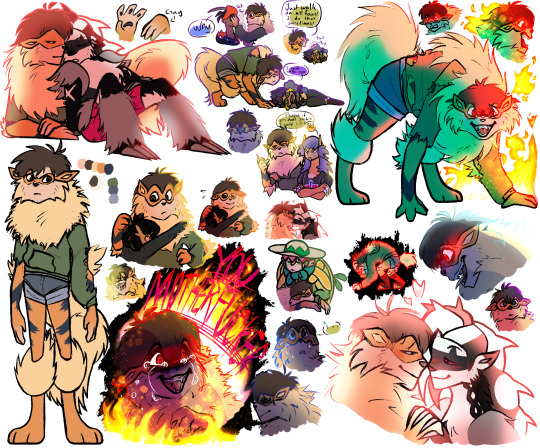
*Slowly walks up to you, cradling this*
*Gently sets it down in fromt of you*
*SPRIN TS THE FUCK AEWAY IN PANIC*
Okay anyways hi I’m back after like, months lol, sorry about that (but I’m not actually back because I’m busy trying not to die because of school-work and trying to work on some MAP parts. I literally said five days ago on my yt channel “Hi I’m back now!! :-D” and school just said “no <3″ which, um, rude. So yeah I might come on and occasionally come post something but I’m really not gonna be coming on here to be active
OKAY OKAY but I need to explain these sketches because they will be suuuper confusing without context, I am very aware, yes, so there’s an explanation (+ some extra art and a non-shaded version of the stuff above) under the cut :-)
BASICALLY, @lulzyrobot made this AU of Pokémon Sword and Shield and now I have brain rot because of it. Also this AU will indeed be confusing to those who have no knowledge about sword and shield so here’s a skippable paragraph about the game:
(OBVIOUSLY SPOILERS BELOW)
Basically, SwSh is just a Pokémon game (no surprise there) and its gimmick or whatever is Dynamax, which turns Pokémon like. Really fucking large. (Some of them can also Gigantamax which changes their appearance as well as size, but we don’t care about that here bc it really isn’t relevant). In all gyms (except one, Spikemouth) there are power spots, which are needed for a Pokémon to Dynamax. If they’re not close to a power spot, they can’t do it. There are also power spots in the Wild Area (which is, you guessed it, an area in the game). At one point in the game, the villain -- Chairman Rose -- starts up something called “the Darkest Day”, which happened before in the Galarian region (which is where everything takes place), in hopes of getting infinite energy for them or something like that (really makes no sense but like ok pop off ig). To do this, he basically uses these things called Wishing Stars -- which are what allows Pokémon to Dynamax -- to summon a Pokémon called Eternatus. In-game, you basically just summon two other legendaries (Zacian and Zamazenta -- they’re on the cover of the games) and fight Eternatus and then catch the fucker. That’s all context you need for this AU so let’s move on to that now:
The AU is basically that Eternatus sends out a powerful blast which fuses trainers with Pokémon, to varying degrees. The closer to a power spot you are, the more likely you are to get it bad. If you’re far enough from one you won’t be affected at all. A person can merge with multiple Pokémon, but the more of them, the harder it is to not go wild. If you merge with a wild Pokémon, you’ll become a Wild Trainer (and those basically act like, well, wild Pokémon).
If you want more info (which you do want, trust me on this), here’s a post made by the creator themself!! https://lulzyrobot.tumblr.com/post/610890677032747008/pokemon-dynamorph-au-masterpost
OKAY ANYWAY, back onto this specific sketch (wow I really went on a rampage there lol)
I decided to Dynamorph my trainersona(??????) (btw, both the Dynamorph version AND the “human” version are WIPs, I’m not completely happy with either of them) and this was the resuulltttt
- Their name is Robin (because I’m a bastard that does self-insert ships with no shame)
- They merged with their Arcanine (and I’m considering also adding a wild Lycanroc, both so I can give them Epic Claws™ and so that their whole extremely volatile nature makes any sense)
- They have some REAL trouble keeping themself in check. Like. They’re constantly on the edge between becoming a Wild Trainer and being “normal”
- Because I am, like I said, a bastard who does self-ships without any shame they are together with Piers. yes I am a simp for him.
- Robin has their select group of friends (made up of all gym leaders minus Opal because they have no idea what the fuck is up with her, as well as Marnie, Hop and Leon. No they don’t give a shit about Bede) which they are super protective of. They have to be reminded that they can all handle themselves, because they might otherwise become a bit possessive.
- While they are a raging storm you do NOT want to get involved with in any way to anybody outside their friend group, they are really nice to be around when they really care about you. They may be pretty stubborn, but they always do what they think is best for their loved ones. On multiple occasions, they’ve gone out to collect any sorts of gifts they can find that they think their friends will enjoy. They are super gentle and kind with Hop and Marnie (which, by the way, they’d literally die for either of them) and they’re overall a good friend/partner. Their main flaw here is their temperament and somewhat possessive nature.
- If anybody did something to even moderately hurt any of their friends... hoo boy, you do NOT want to do that. They’ve nearly killed people for leaving so much as a scratch on their loved ones, and have to be physically dragged away so they won’t really kill somebody.
- However. Despite really, truly believing they'd never, under ANY circumstances, hurt ANY of their friends... they’re wrong about that. The only ones they could truly never purposely cause harm to would be Piers, Marnie and Hop. Yes, it would take A LOT for them to hurt any of the others (like, they’d only hurt the others if they tried to, idk, kill them or something. Or if they tried or actually did kill somebody else in their close circle) but it could hypothetically happen.
- If they ever were to see Rose, he’d probably be torn to shreds on sight. Literally nothing would be able to stop them.
- While it’s near impossible for anybody they don’t care about to calm them down, it’s pretty easy for especially Hop, Marnie, Piers, Raihan, Leon and Milo (and the others, but less so for them lol).
- They were right by a power spot, like they were about to step into a den, when the blast happened so they were. Really fucking affected by it. They stayed in the Wild Area for a while after that, searching for their Arcanine who had “mysteriously vanished”, before they transformed. They were basically a Wild Trainer for at least a month before Piers found them and managed to get them to remember who they actually were over the course of two days. It was,, really concerning when they’d at first been texting him pretty much non-stop to update him on what was going on with them just to then go radio silent for a few days, especially since people had begun transforming at that point. Haha angst go brrr
- You must ignore how their clothes still kind of fit despite them growing to be both more ~muscular~ and tall and how it’s not dirty for the sake of my convenience ok
Ok I think that’s all? woah that was a long post lmao
Anyways, here’s the promised extra art (first one is the same sketch without any shading and that stuff (buT I MISSED ONE, I DIDN’T REMOVE THE SHADING FROM ONE I AM SORRY LOL), second is Robin as just a regular trainer)

Oh also some context for some of the sketches:
Bottom one where they’re screaming “yOU mOthErFuCKeR” is what their reaction would be to one of their loved ones being killed
The one with Milo is Robin just. Being near him. After probably having some sort of panic or anxiety attack because they’re worried about everyone. Because Milo is a really calming person to be around.
Top one in the middle is Robin just patting the red eye-lens-things Raihan got from his Flygon because they find it to be Very Entertaining to just pat them for no reason at all.
The ones where they’re hugging Marnie would take place right after they come back to Spikemouth after their month(s) as a Wild Trainer. They still weren’t used to being around people (and much less BEHAVING like a PERSON) so they were pretty awkward about Marnie hugging them.
The one where they’re surrounded by darkness to the right and kneeling forward is them in the middle of their “transformation” after the blast happened.
Fiery ones at the top right are just Robin being pissed as fuck lol
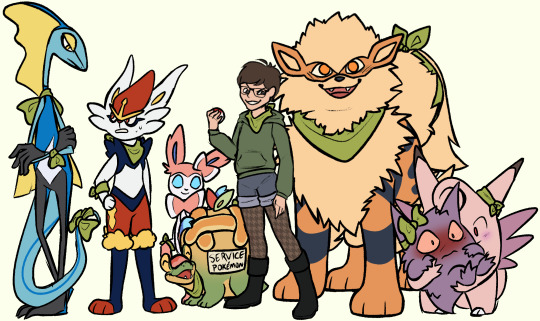
(Still haven’t decided if this will be the “official” team of Pokemon I have, but it’s cool for now. Also yes, I added an extra Pokemon to my “team” who isn't actually a battle-Pokémon or whatever. I NEED APPLETUNS EMOTIONAL SUPPORT OKAY)
#dynamorph au#dynamorph#Pokémon#pokemon swsh#pokemon sword and shield#piers#pokemon piers#raihan#pokemon raihan#hop#pokemon hop#milo#pokemon milo#marnie#pokemon marnie#leon#pokemon leon#inteleon#cinderace#sylveon#appletun#arcanine#gengar#clefable#yes my gengar and clefable are dating what about it#yes I gave all my pokemon matching accessories what about it#self ship#you can't stop me#this is my world and you're all just living in it#(that was a joke I've started to make jokes playing myself up way too much to be serious instead of self-deprecating jokes)
63 notes
·
View notes